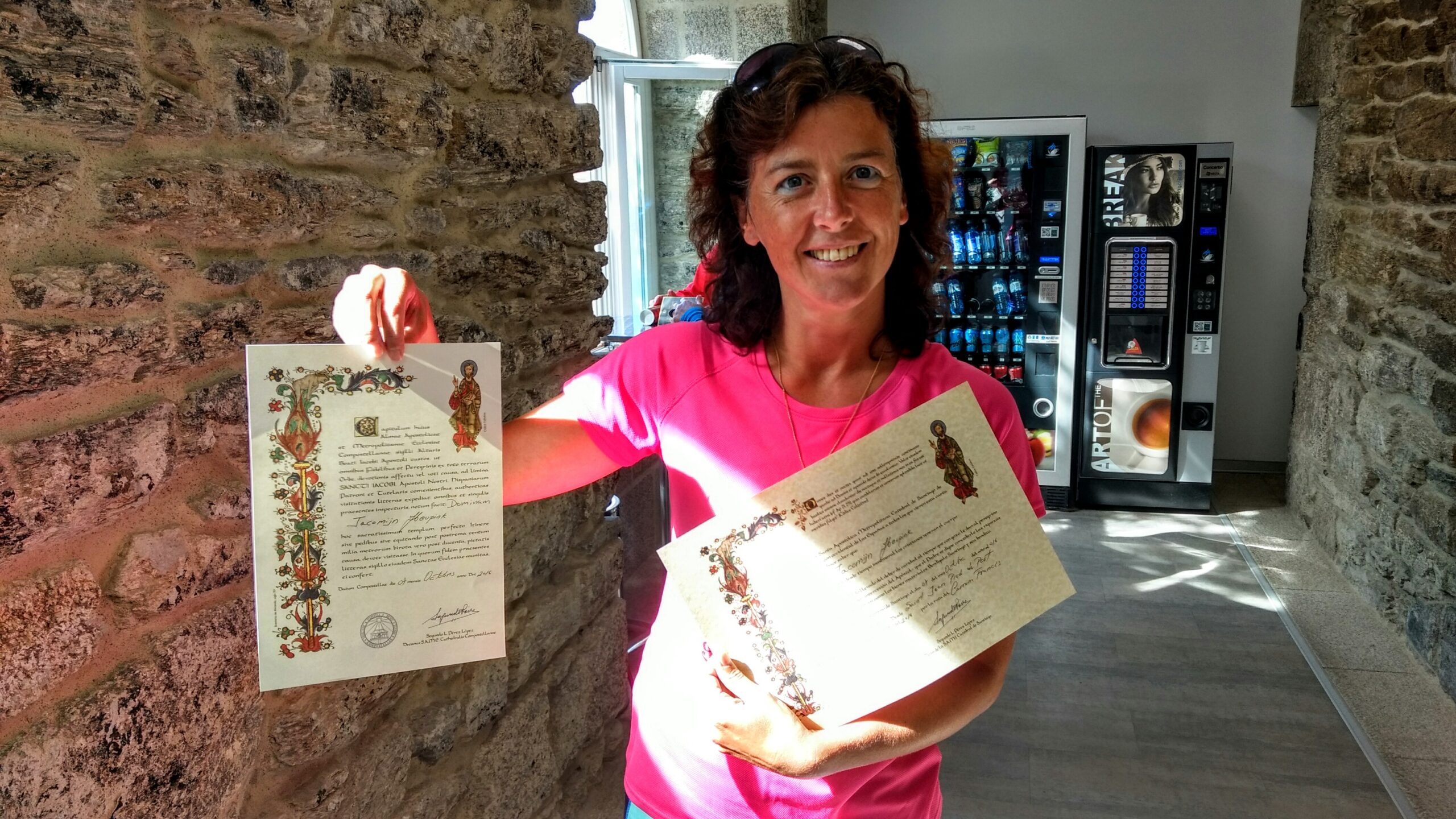A personal story about the emotional final week of my pilgrimage from Villafranca del Bierzo to Santiago de Compostela. When I wrote this, it was a month ago that my Camino Frances ended… I had just completed a walk of 780 km! Looking back on this adventure? It is by far the best travel experience ever.
I still miss my pilgrim life… my Camino Family…
I’m in Colombia now and writing my experiences from the last week of my Camino Frances. In the meantime, I’ve visited Portugal and been to Cuba… But in my thoughts, I’m still that pilgrim…
So let me write some more about it… I like to daydream about my pilgrimage
My last update ended when I was in Villafranca and I’d already walked for 29 days…
Galicia: The Mystical Final Section of the Camino Frances
I still had a few days to walk before I’d arrive… It was getting colder as we climbed higher into the landscape of Galicia. Galicia, the northwestern region of Spain, is the magical final section of every Camino Frances. This green, hilly province is known for its Celtic heritage, ancient traditions, and the mystical atmosphere that perfectly suits the spiritual character of the pilgrimage.
The weather in Galicia: October is a wonderful month to walk through Galicia on the Camino Frances. The morning mist (Galician: “brétema”) is typical of this area and creates that magical atmosphere that every pilgrim remembers. Temperatures range between 8-15°C, with regular fog banks in the early morning giving way to clear afternoons.
But precisely because of that, the mornings were truly amazing! The morning mist made it so beautiful to walk here now on the Camino Frances. On the other hand, I did miss benches along the route on this section. Only in the villages along the route could you sit down, and of course, you could also get a cafe con leche there right away… Not bad either, of course!
The final kilometers of my amazing experience
Day 30: La Faba to Tricastela – The Transition to Galicia (26.2 km)
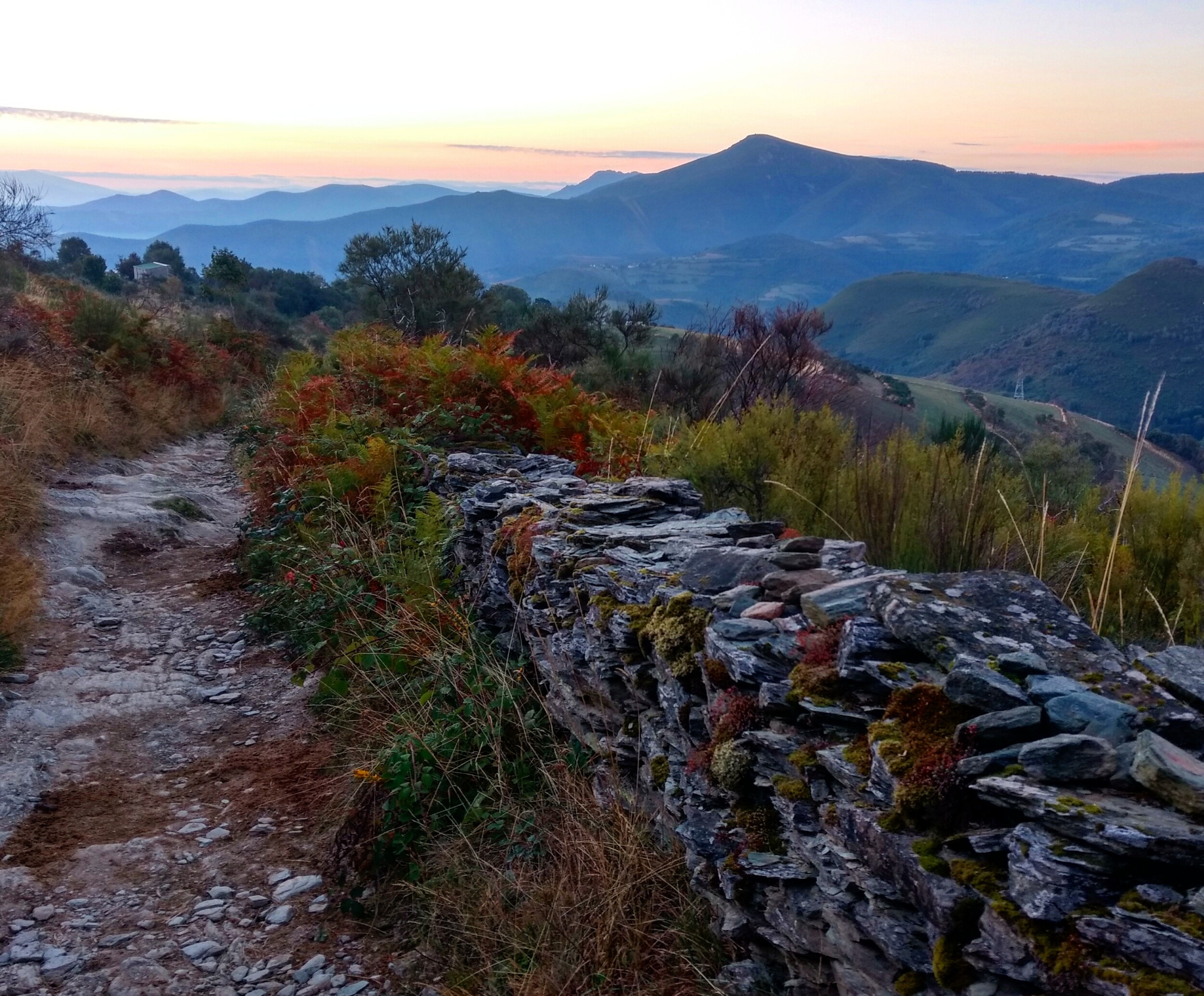
I started early in the morning climbing up the mountain. The day before I’d already done most of it, so I’d saved only the hardest part for this morning.
O Cebreiro and Alto de San Roque: This part of the Camino Frances marks the official border between Castilla y León and Galicia. O Cebreiro (1,300m altitude) is one of the most iconic villages on the entire pilgrim route. The traditional stone houses with thatched roofs (‘pallozas’) date from pre-Roman times and give you the feeling that time has stood still here.
The view back to the sunrise was amazing!
The higher I got… and closer to O Cebreiro… the village on top of the mountain… the colder it became. It was foggy and therefore extra cold! The wind made it even worse… And when I was on top of the mountain, I loved having a warm cup of coffee with Lola and her company, both from Australia.
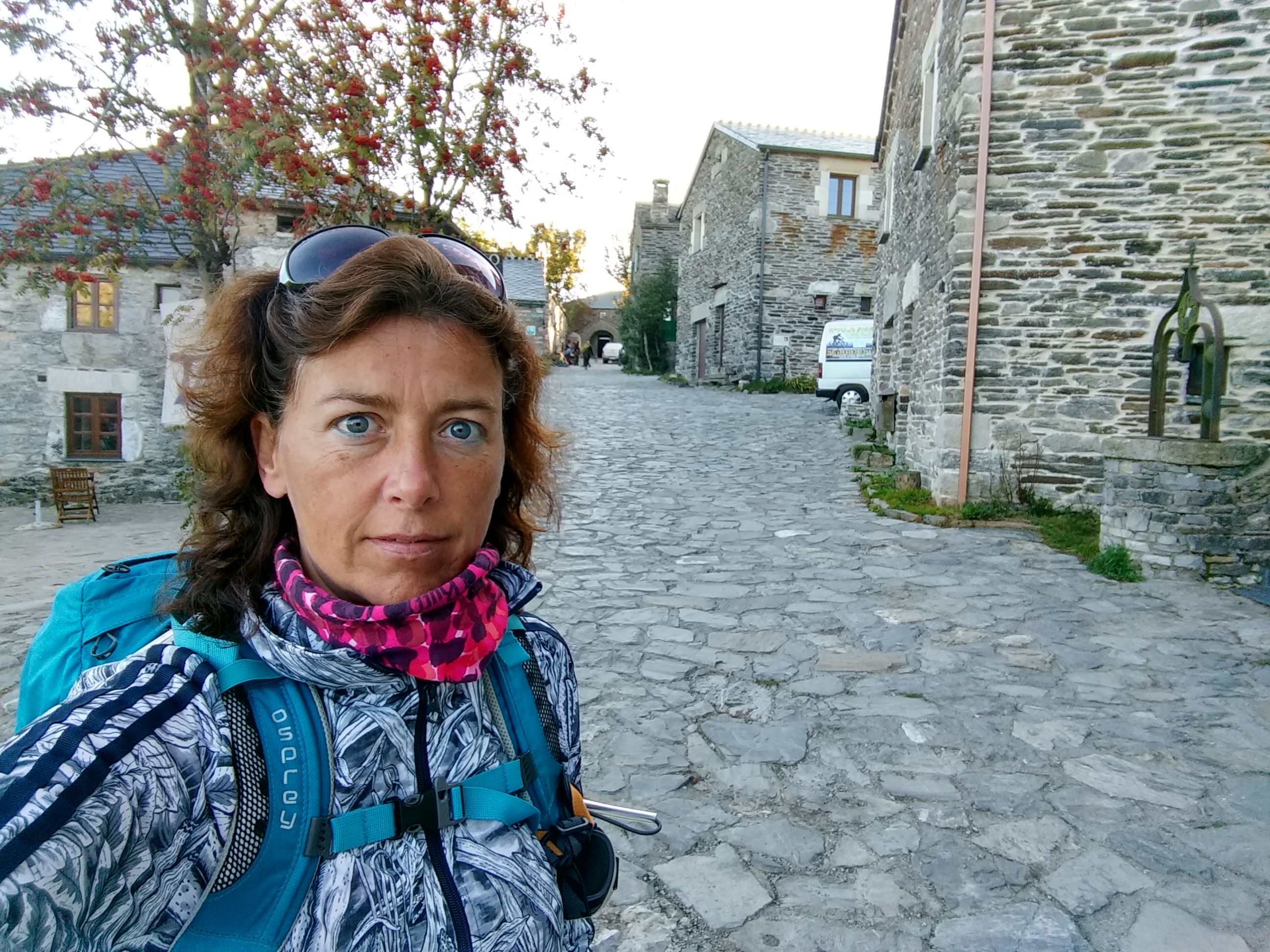
After that lovely warm coffee, the weather started to clear up too… but as you can see from me and my clothing, it was still quite chilly!
I had an amazing day, the views were wonderful along the way! At some point, I was looking for a place to have lunch when I walked through a village. There was an elderly lady standing by the side of the road. She was dressed in pants, a dress, a long coat… she was apparently still cold 🙂 She asked me something and I couldn’t immediately understand her. Then she asked me where I was from… I told her I was Dutch.
Then she asked me if I wanted a pancake 🙂
Haha, amazing! She knew the word in Dutch and on the sign she held in front of her, there was still 1 pancake left for me. She sprinkled some sugar on it and asked if I had a donation for her. Of course I did and paid her one euro. I asked to take a photo of her but she pointed once at all the clothes she was wearing and said she’d rather not… What a nice photo that would have been for that very reason 🙂
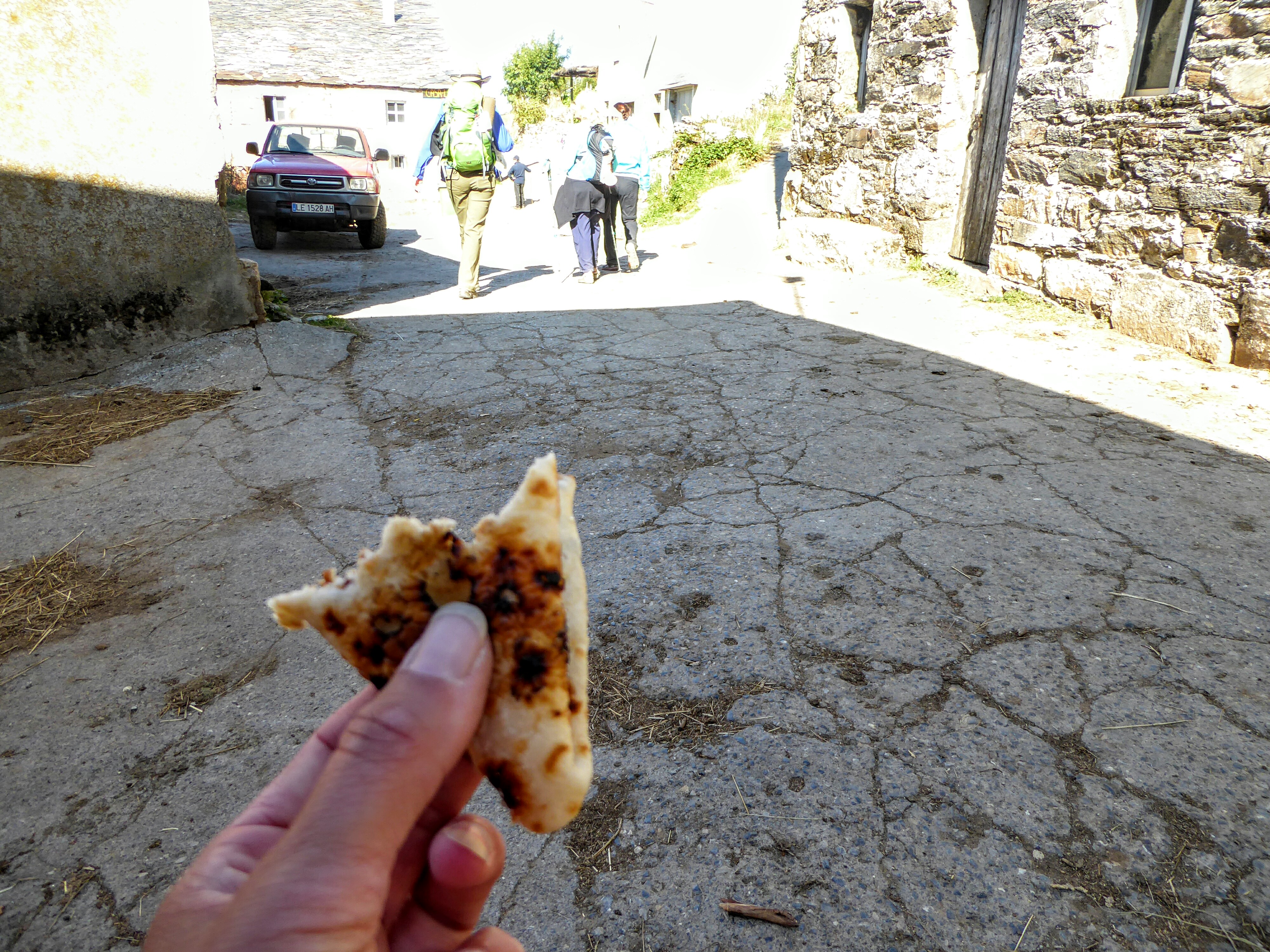
I still had some olives and at some point I’d found a spot with a beautiful view. I sat here for a bit and enjoyed my olives with a view!
Isn’t that an amazing view?
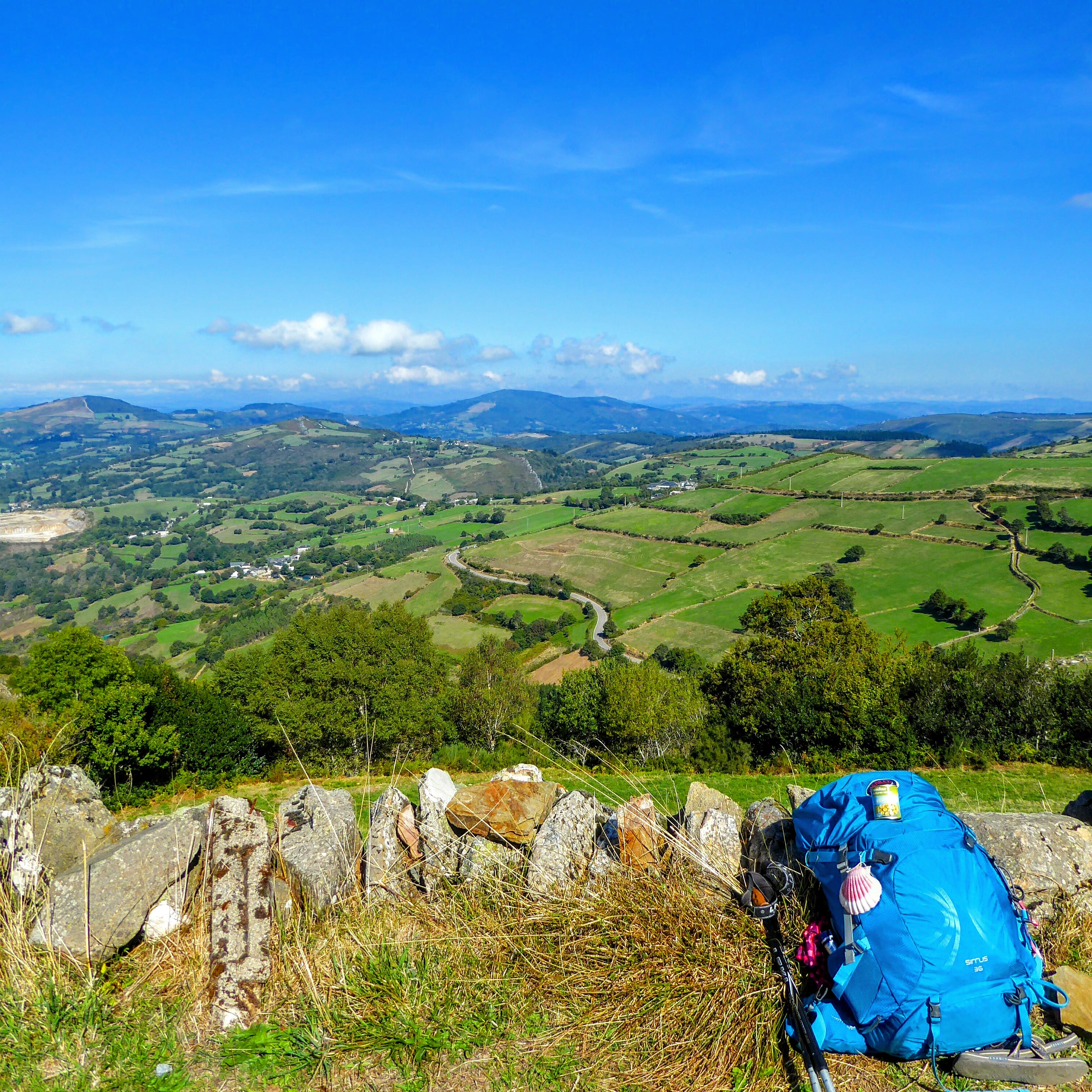
Just before Tricastela I walked through the village of Ramil. I’d already read in my Camino Frances guidebook that this was mentioned because there’s a tree there that’s centuries old! 800 years no less. I’d hoped I wouldn’t miss it… but when I entered this village, it became clear to me that I certainly couldn’t miss it.
This magnificent specimen was right in the middle of the road!
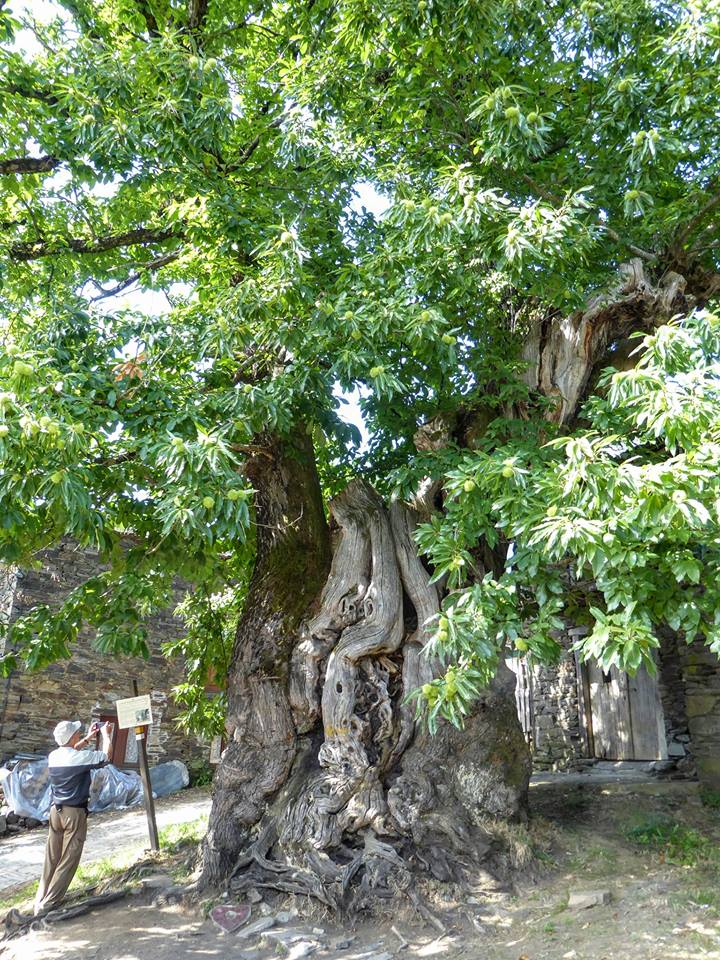
This chestnut tree (Castañeiro de Ramil) is a protected natural monument and one of the oldest trees in Galicia. With a circumference of more than 10 meters and an estimated age of 800-1000 years, this tree has seen generations of pilgrims pass by. It’s a beautiful symbol of the continuity of the pilgrim route through the centuries.
Day 31: Tricastela to Barbedelo via Samos (29.1 km)
From Tricastela, you can take several routes to Barbedelo. I naturally took the route that’s the most beautiful, which is also always the longest route… I chose this route because it took me past the famous village of Samos.
The alternative routes from Tricastela: Pilgrims have a choice between two routes here:
- The Samos route (29 km): Past the famous monastery, longer but culturally richer
- The direct route (25 km): Via San Xil, shorter but fewer sights
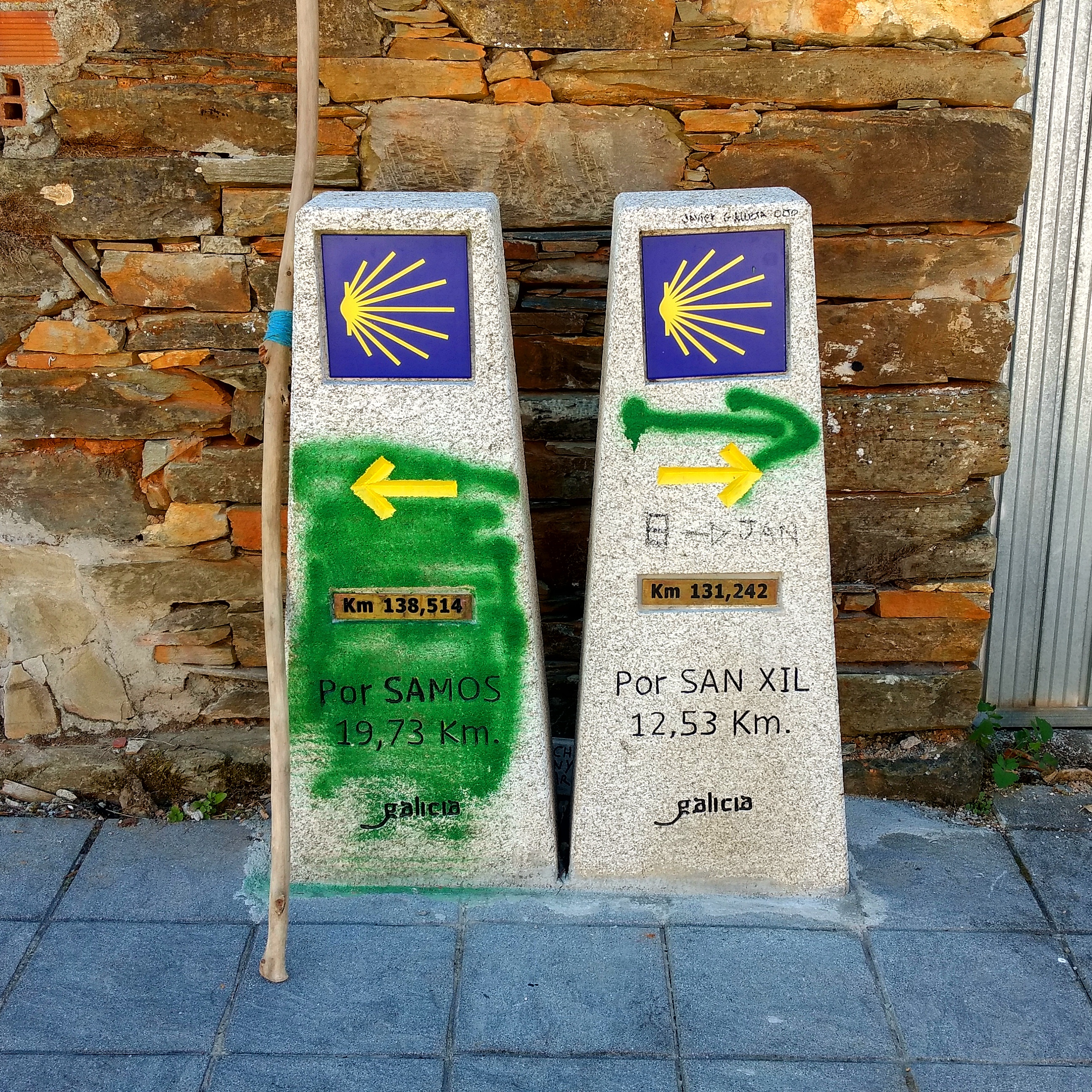
Monasterio de Samos: Samos is known because there’s an amazingly old monastery there and I naturally wanted to see it. The Benedictine monastery of Samos is one of the oldest monasteries of Western Christianity, founded in the 6th century. The current buildings date mostly from the 17th and 18th centuries after various fires. The monastery still houses an active community of monks and offers tours to pilgrims.
The path there first took me along the main road but then through super old and forgotten villages in the Galician landscape. These hamlets (Galician: ‘aldeas’) are typical of rural Galicia: stone houses, narrow streets, and an atmosphere as if time has stood still. Many of these villages are fighting depopulation, which gives the landscape a melancholic but authentic atmosphere.
Time has really stood still here… about 100 years ago… Really very special to see. It was still fairly dark so I couldn’t take good photos.
I didn’t encounter any pilgrims on this entire road until I was in Samos a few hours later. First I went to the monastery and found out that only the shop was open. So I could only get a stamp there and not visit the monastery yet. Then I walked to the first restaurant I could find and sat down for breakfast. Again I saw Maureen from Australia, she also walked the long route… alone. I would start seeing her more and more often from now on.
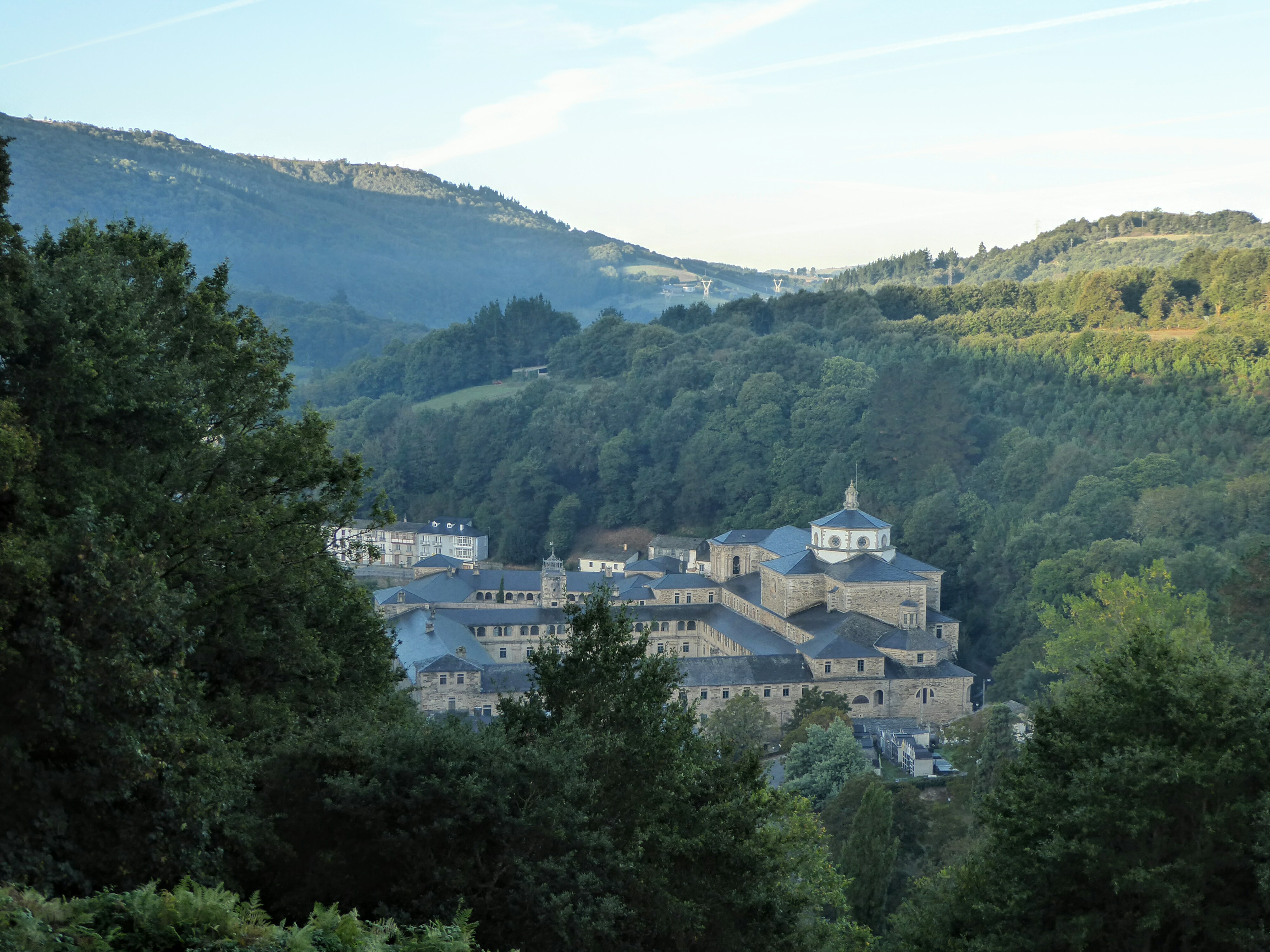
Isn’t that an amazing view?
I walked on to Barbedelo. This is a village a few kilometers after Sarria. Sarria: The starting point of the last 100 km: Many Spanish pilgrims start there because then you walk the last 100KM and so it would be busy. Sarria is the most popular starting place because it’s exactly 111 km from Santiago – the minimum you must walk to get your official Compostela certificate. This causes a significant increase in pilgrims from this point.
I didn’t feel like that, so I kept going. There were already warnings that the camino would be busier from now on because of these new participants, pilgrims. So I went away from the most mentioned stops in the guidebooks and hoped not to end up in the groups that were just starting. They told me they were quite party people and not so much the pilgrims like I’d been experiencing for almost a month…
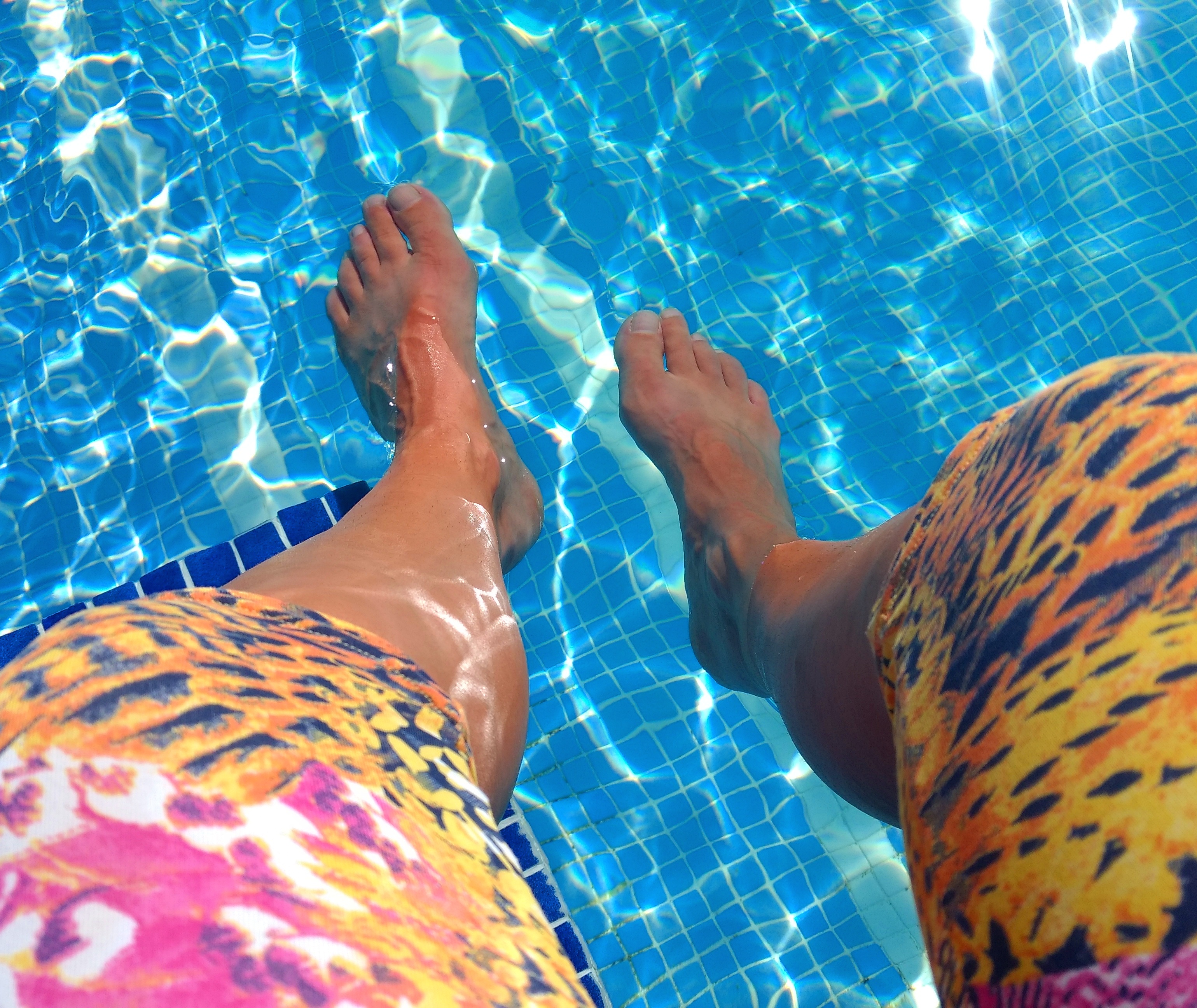
In the tiny village of Barbedelo (15 people lived there) I found a wonderful albergue with a swimming pool! This is really wonderful about the pilgrimage! I’ve now had a hostel with a swimming pool several times for just 10 euros a night. 10 euros for a bed, a shower, and a swimming pool!
Accommodation in Galicia: Galician albergues are known for their good value for money. Many have extra facilities such as swimming pools, gardens, or traditional Galician architecture. Barbedelo’s Casa Barbadelo is a perfect illustration of how small villages welcome pilgrims.
How good is life as a pilgrim?
Do you want to experience this too? Walk the last 200 km of this beautiful path with me. Read all about the guided pilgrimage to Santiago de Compostela.
Day 32: Barbedelo to Ventas de Narón (31 km)
After walking about 8km, I arrived in a village where the 100km marker should be. The 100 km stone at Sarria: There are several stones claiming to mark ‘100 km to Santiago’, but the official one stands just after Sarria. This milestone is emotionally significant for every pilgrim – you’ve officially started the final part of your journey.
First you come across one that’s fake… but a little later I was really at the last 100km! Of course, I made a little video! I was happy I’d made it… Closer to my goal, I was going to make it!! Not that I’d ever doubted it… but still… I’d been walking for 32 days and I just kept going and going and was getting closer and closer… It felt great!
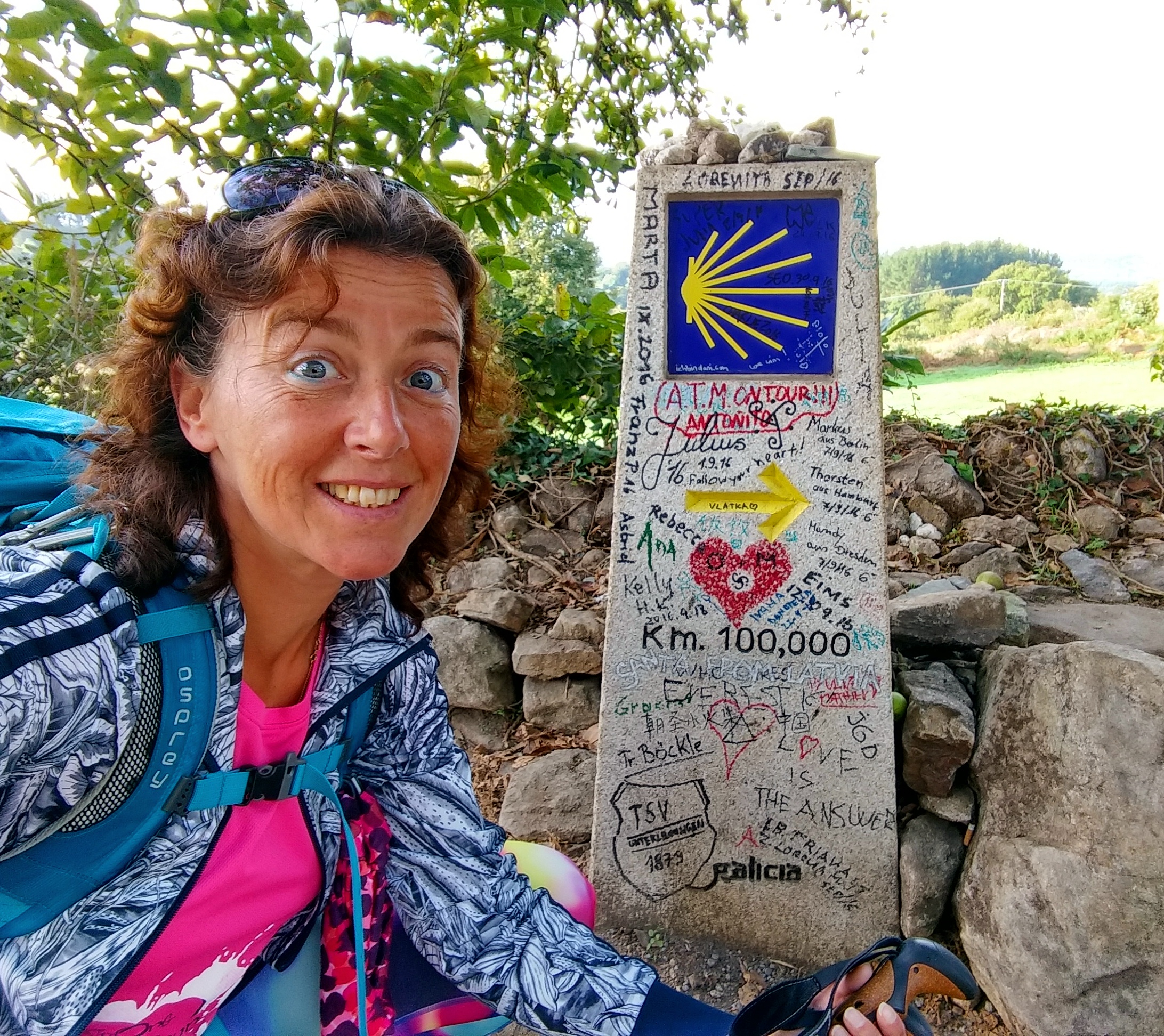
It would be a long day with 31 km. I wanted to go past Portomarin. Portomarin: A rebuilt town: The current Portomarin was rebuilt in the 1960s when the old village was flooded due to the construction of the Belesar reservoir. The historic church and several other buildings were moved stone by stone to the new location on higher ground.
It was a beautiful day of walking and a few km before Portomarin I met 2 men who were staying overnight in Portomarin. I walked with them until there and then at the gate to the city of Portomarin, I ran into Maureen again. She also wasn’t stopping and wanted to go to the next village like me. It was half past eleven, so we still had plenty of time. A lunch stop in the next place seemed like a good idea.
The lunch stop was still 7 km away while our guidebooks said otherwise. After 7km without encountering anything along the way, I sat down by the side of the road at a kind of restaurant. I quickly saw a familiar face: Ignasi! He welcomed me and we talked briefly. It had been a long time since we’d seen each other.
I thought that was truly amazing about the Camino Frances
The Camino Family: I thought that was truly amazing about the Camino Frances. Sometimes you don’t see each other for days, weeks, and then suddenly you see each other again. This phenomenon is called ‘Camino Magic’ – the way pilgrims keep running into each other, often at moments when they need it most. It reinforces the sense of community and connection that makes the pilgrimage so special.
I’d walked with Jerry and Terry for a while and I’d seen Ignasi during that time. I think I saw him last in Sahagun when we slept in that old church. Ignasi told me I shouldn’t stop in the next village but one further, there were better albergues and a small shop. And then we would see each other again.
I had my lunch and Maureen also just walked in. She was also surprised about the distance between. She sat down and ordered lunch.
I left Maureen behind again and started walking. I went to the second village and checked in but the first albergue was full. When I went to the second hostel, I did get a bed. It was a very small village but they still had two hostels. It didn’t take long before I also met Barclay, the man Ignasi had been walking with for a few days. Nice! To my surprise, I also suddenly saw Sean walking, the Irish man I’d already run into many times. I hadn’t seen him for 2 weeks either!
Day 33: Ventas de Narón to Melide (27 km)
It was getting colder in the mornings, it was foggy but beautiful! Galician morning mist: The ‘brétema’ is a daily phenomenon in Galicia, especially in the autumn months. This mist arises from the combination of Atlantic influence and the hilly landscape. For pilgrims, it creates a mystical atmosphere that perfectly suits the spiritual experience of the Camino.
I started when it was still dark and was treated to this beautiful sunrise. The mist really made it beautiful, right?
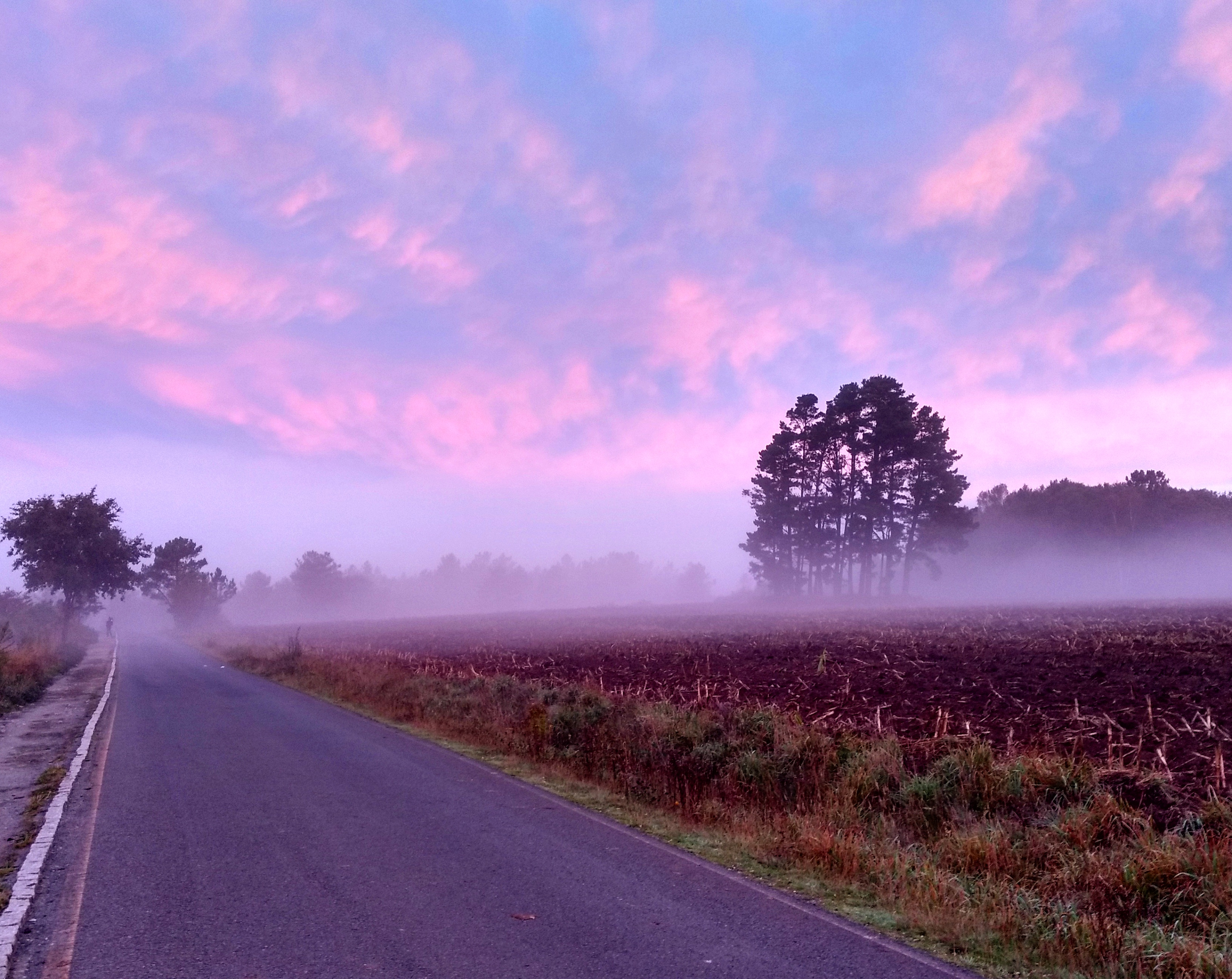
And a little later I had this view… Remains amazing!
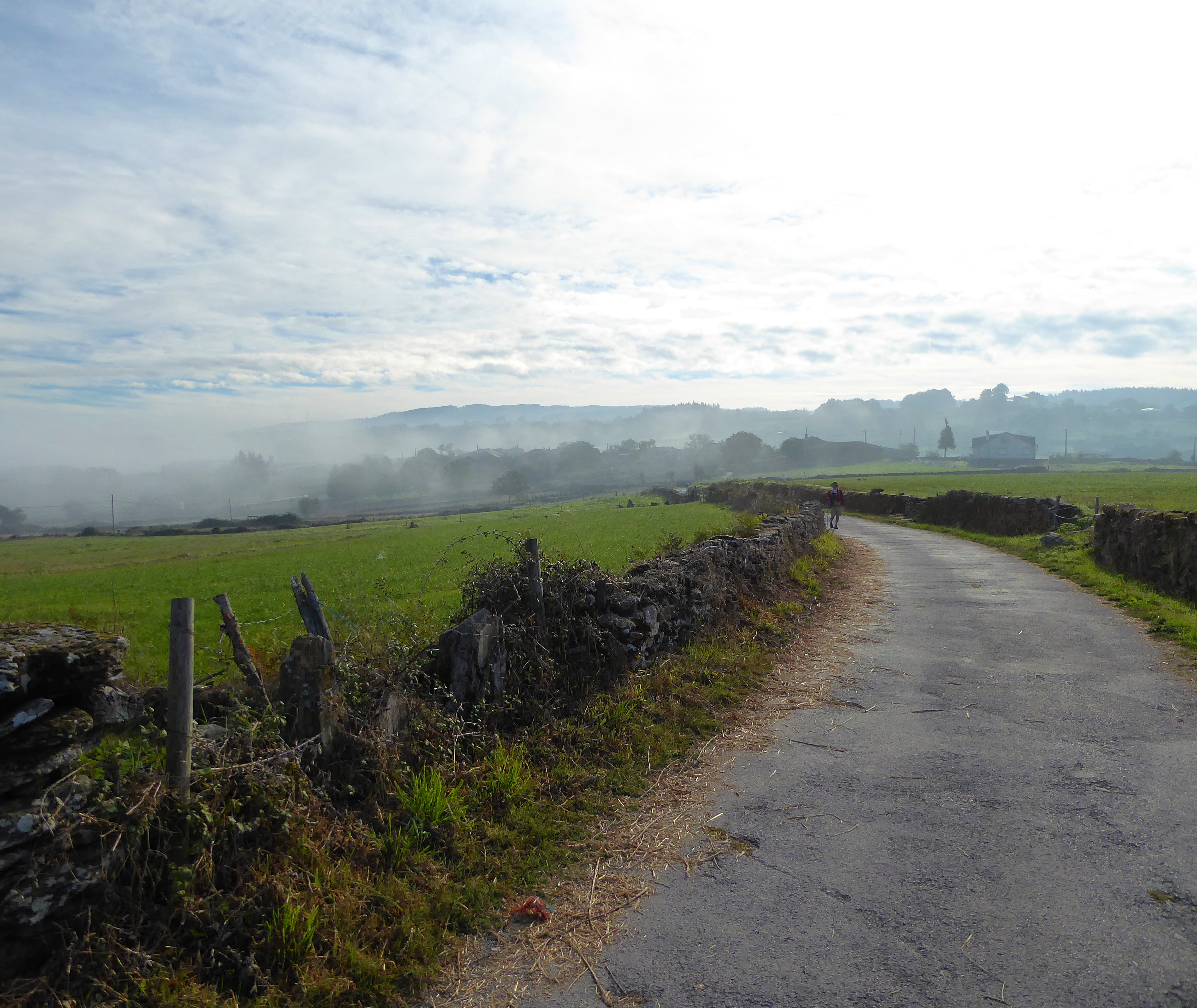
I wanted to walk 27km this day and Ignasi told me that we wouldn’t see each other again then. He was walking with his friend Camino Barclay and he didn’t walk that many km’s. We’d already exchanged phone numbers so we could still keep in touch.
The day was beautiful but I couldn’t really find the places where I could rest and buy a cup of coffee and tortilla. Where I could finally get coffee, they didn’t have tortilla but a dry piece of bread. That was really a shame and I missed that…
Facilities in rural Galicia: They really had that better organized in the first few hundred km of the Camino Frances! In the more remote parts of Galicia, facilities are more sparsely distributed than in the earlier stages through Castilla y León. This is partly due to the lower population density and the more mountainous character of the landscape.
Now, in 2025, I have to say that quite a lot has been added and there are enough facilities to enjoy your day’s walk on the Camino.
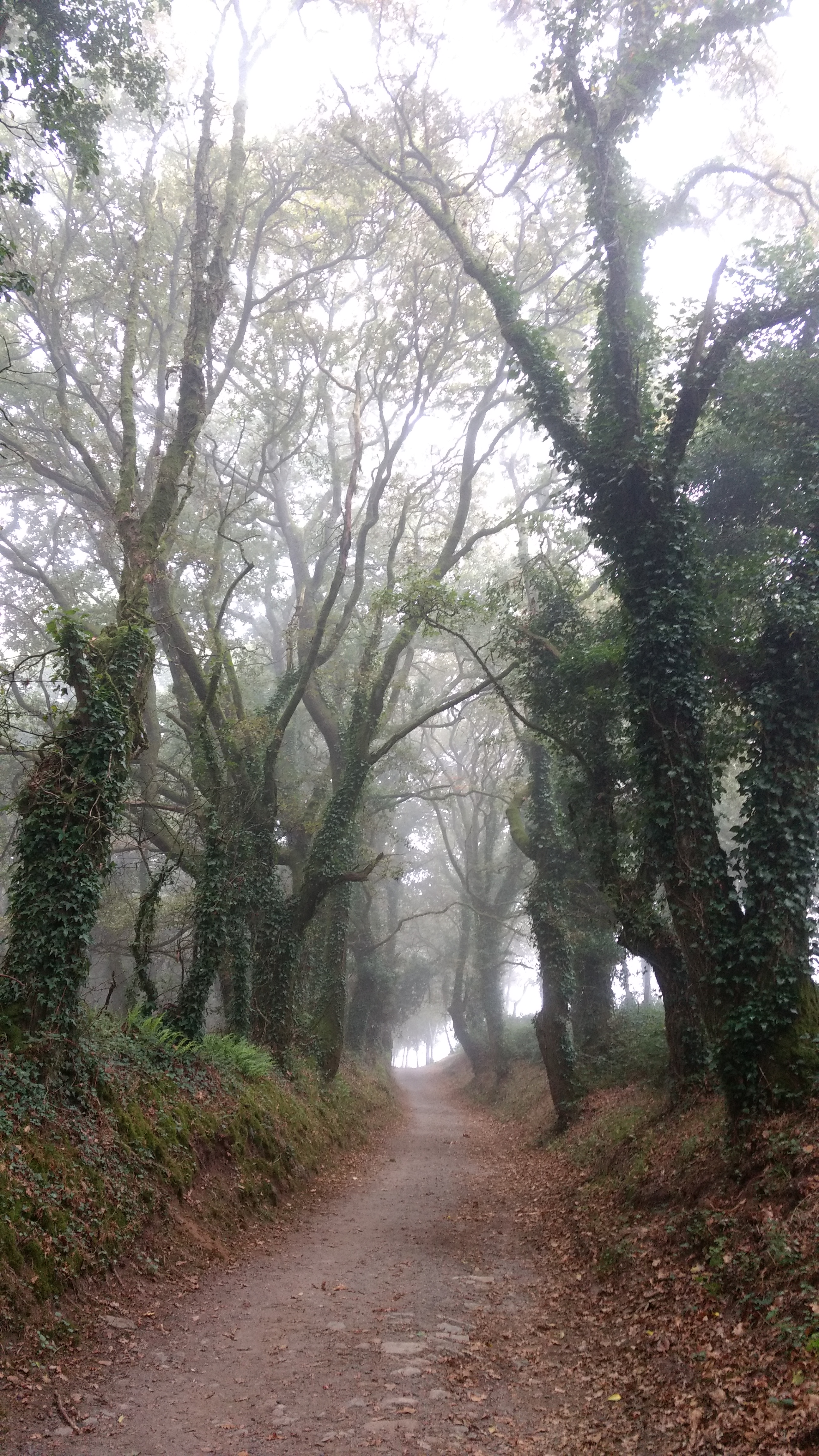
At some point, I was having a cup of coffee on the side when Sean came walking by. Had a nice coffee together and a little later I walked on. In Melide I found the municipal albergue and not long after I checked in, Sean walked in.
And then I got a message from Ignasi. He told me he was also in Melide and that he was going to eat pulpo. I thought WHAT? I didn’t know what it was but Ignasi explained it. It was octopus and… it was a specialty in Melide.
Pulpo à Feira – Melide’s Culinary Tradition: Hmm… I’m not really into octopus but I wanted to try it. Melide is known as the ‘pulpo capital’ of Galicia. This tradition goes back to the Middle Ages when pilgrims were treated to fresh octopus from the nearby Atlantic coast. The dish is prepared in large copper kettles and served with coarse sea salt, paprika, and olive oil on wooden plates.
And it seemed nice to me to have something to eat with Ignasi, so I made an appointment.
That afternoon I ate Pulpo in Melide – Pulpo City! I have to honestly admit that I did find it tasty. It was really meaty and I didn’t expect that. It was nicely seasoned with some paprika and oil. I can recommend trying it. To be honest, I didn’t like the edge but I did like the inside. The edge still has the squid’s suction cups on it 🙂
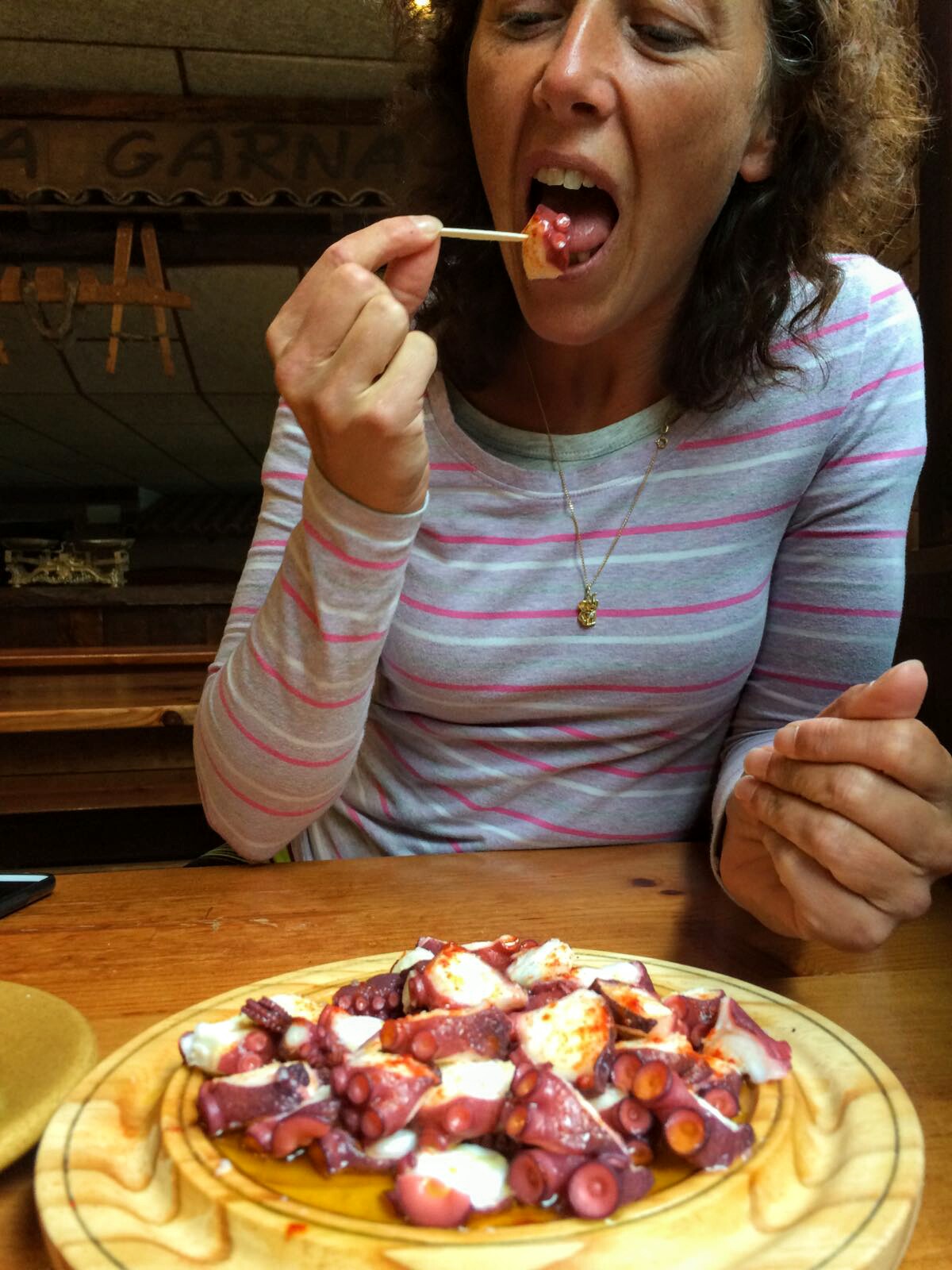
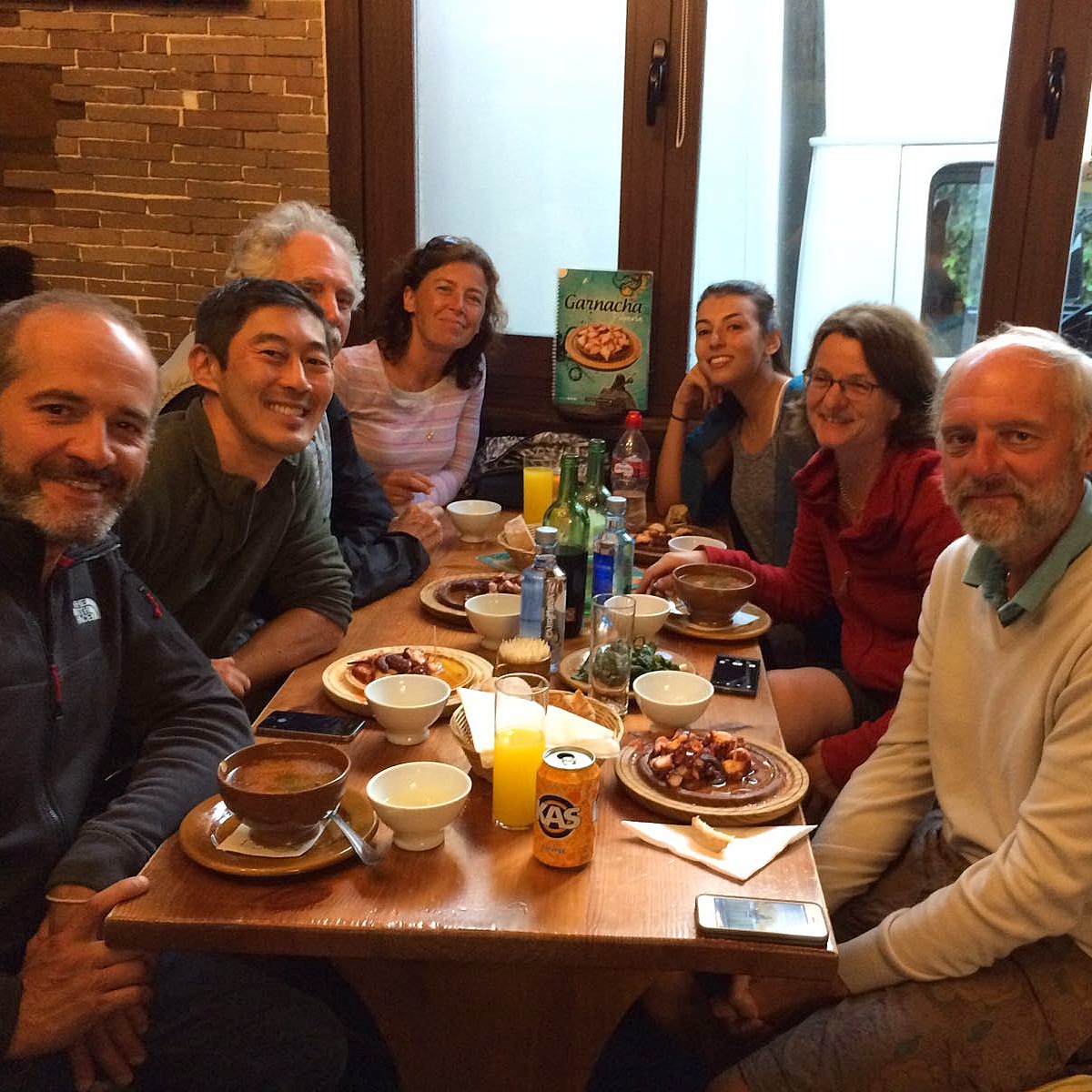
That evening we sat at the table with a nice group. The whole group naturally ate pulpo! But this time I chose something different… Not again 🙂 The group you see sitting at the table above has 7 nationalities: Belgian, German, Inbar from Israel, Fernando from Brazil, Barclay from Canada, and Ignasi from Barcelona… I won’t say Spain because he lives in Catalonia of course… and me from the Netherlands.
International pilgrim community: This perfectly illustrates the international diversity of the Camino Frances. Especially in the final section, pilgrims from all over the world come together, united by the same goal and shared experiences.
Day 34: Melide to Pedrouzo (39 km)
My guide indicated that I should go to Pedrouzo the next day. It would be about 35 km but other books said it was more… I wanted to arrive in Santiago on Friday, so I walked this distance. It was Thursday so I was going to walk those km’s. If you arrive on Friday you have the big pilgrim service and then the botafumeiro is also lit.
The Botafumeiro Tradition: My guide said this only happened on Friday afternoon so I wanted to be there then! The botafumeiro is a huge incense burner (1.60m high, 80kg heavy) that swings through the cathedral on ropes. Originally this was used to mask the smell of thousands of unwashed pilgrims. Nowadays it’s only used on special days, including Friday afternoons during the pilgrim service mass.
So I started early that morning, at 7:15 AM I was still having a cup of coffee at a hostel in Melide. At that moment, I got a message from Ignasi that he was already walking. He was walking alone because Barclay wasn’t feeling well and wanted to make it a short day. Barclay was going to walk with Israeli Inbar who also had all the time.
After a few km on the road, I suddenly saw Ignasi sitting by the side of the road. He was eating his breakfast. I sat down with him, also ordered a breakfast and a little later we were walking together on the Camino Frances. It was very nice together and we had a connection!
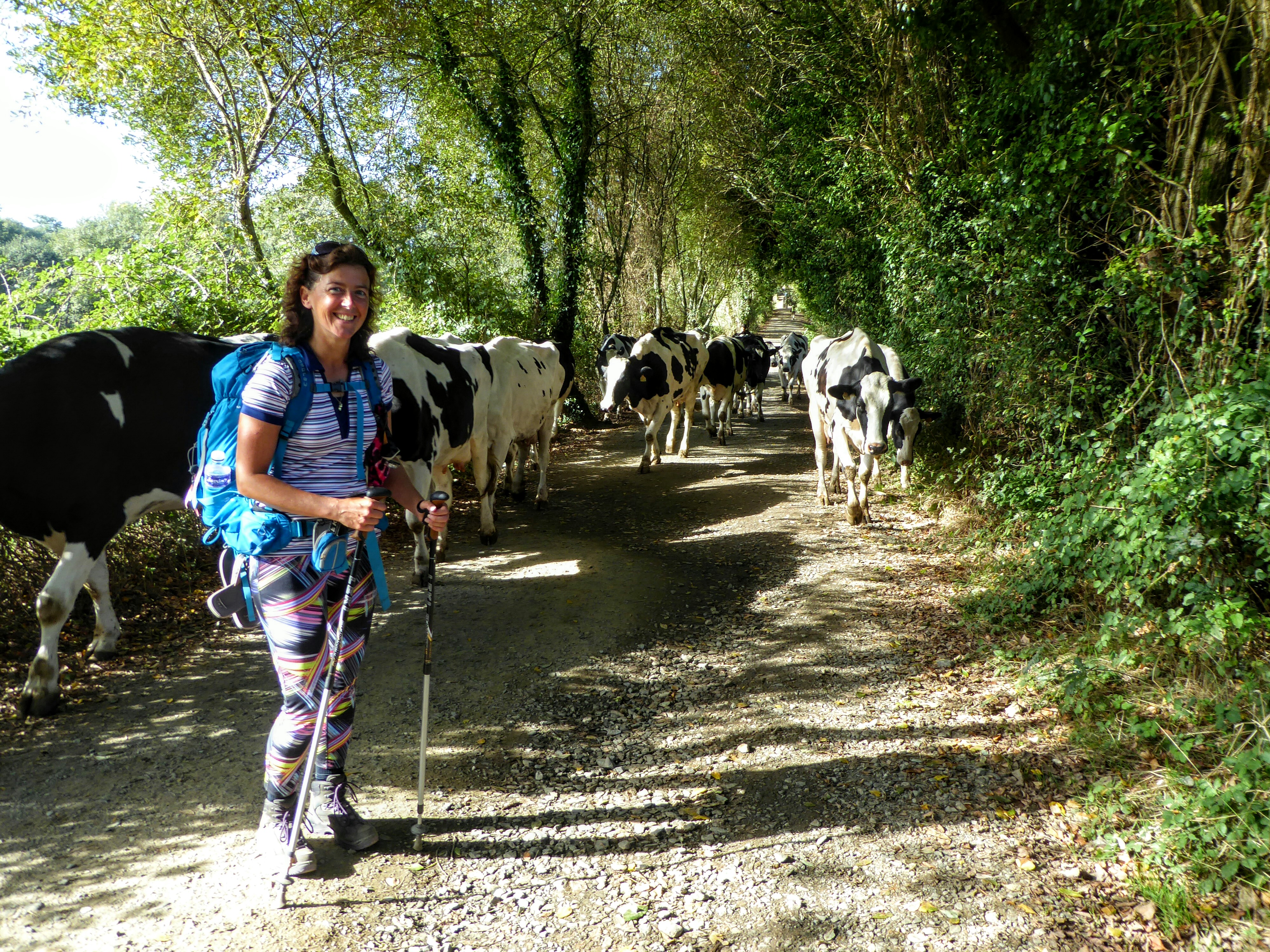
We even came across some Dutch cows 🙂
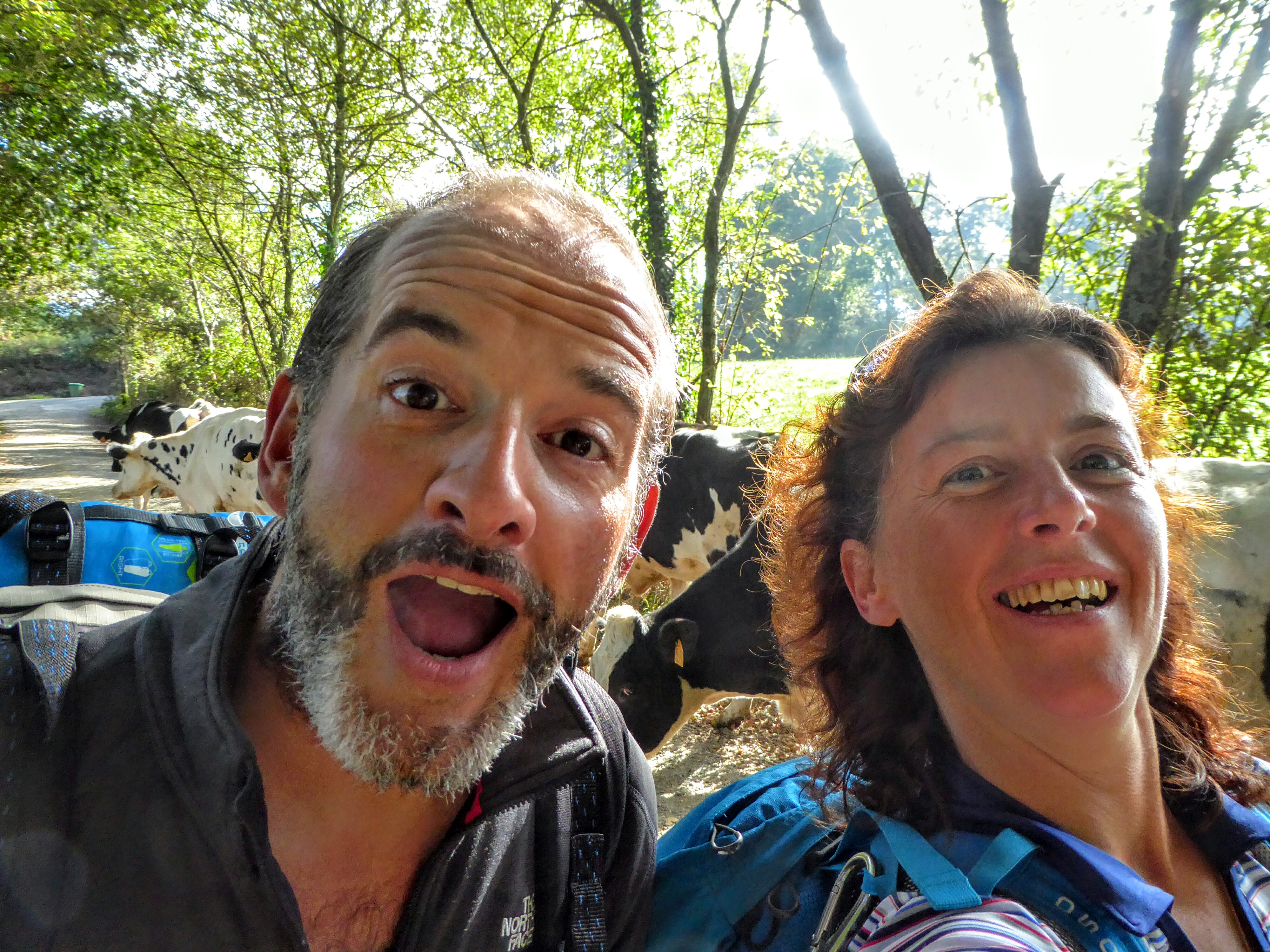
Galician agriculture: The landscape between Melide and Pedrouzo is typical of rural Galicia: small farms, ancient stone walls, and pastures with cows. Agriculture here is still largely traditional, with small family farms that have been in the same families for generations.
We went to Pedrouzo and had a good day of walking behind us. I had walked a bit too fast so I had some problems with my shins. I got an ointment from Ignasi to rub on it, he’d been using this just after Sahagun he told me. Today he’d walked briskly because he thought this was my pace. On the Camino Frances, I really had the reputation of being a fast walker… Today it had gone too fast though…
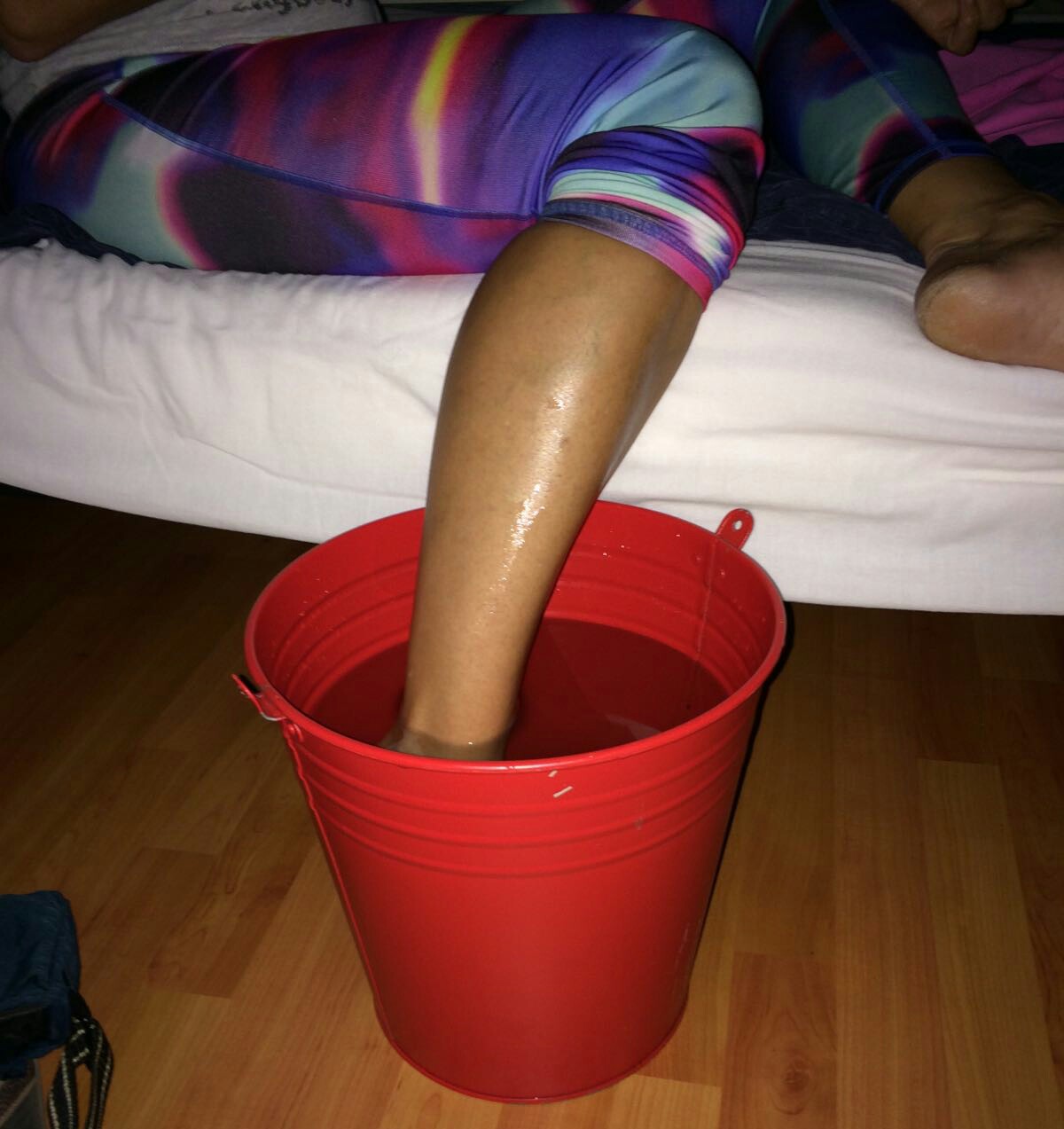
Day 35: Pedrouzo to Santiago de Compostela – The End of the Journey (20 km)
We started walking that day on the Camino Frances and fortunately I had no more pain. Ignasi and I decided to walk nice and easy and take our time on this last day. We did start early so we would be in Santiago around noon. That’s naturally a nice time to arrive, on that big square… at that big cathedral!
We had a cup of coffee after 3 km. Of course I saw Maureen there again and her 2 friends. They’d decided to walk together today, the last day. Everyone was in a different mood today, for everyone it was the last day. It was strange… You could just see and feel it in everything… Everyone was taking their time for everything and was already looking back on how it went…
Ignasi and I walked on and had fun together!
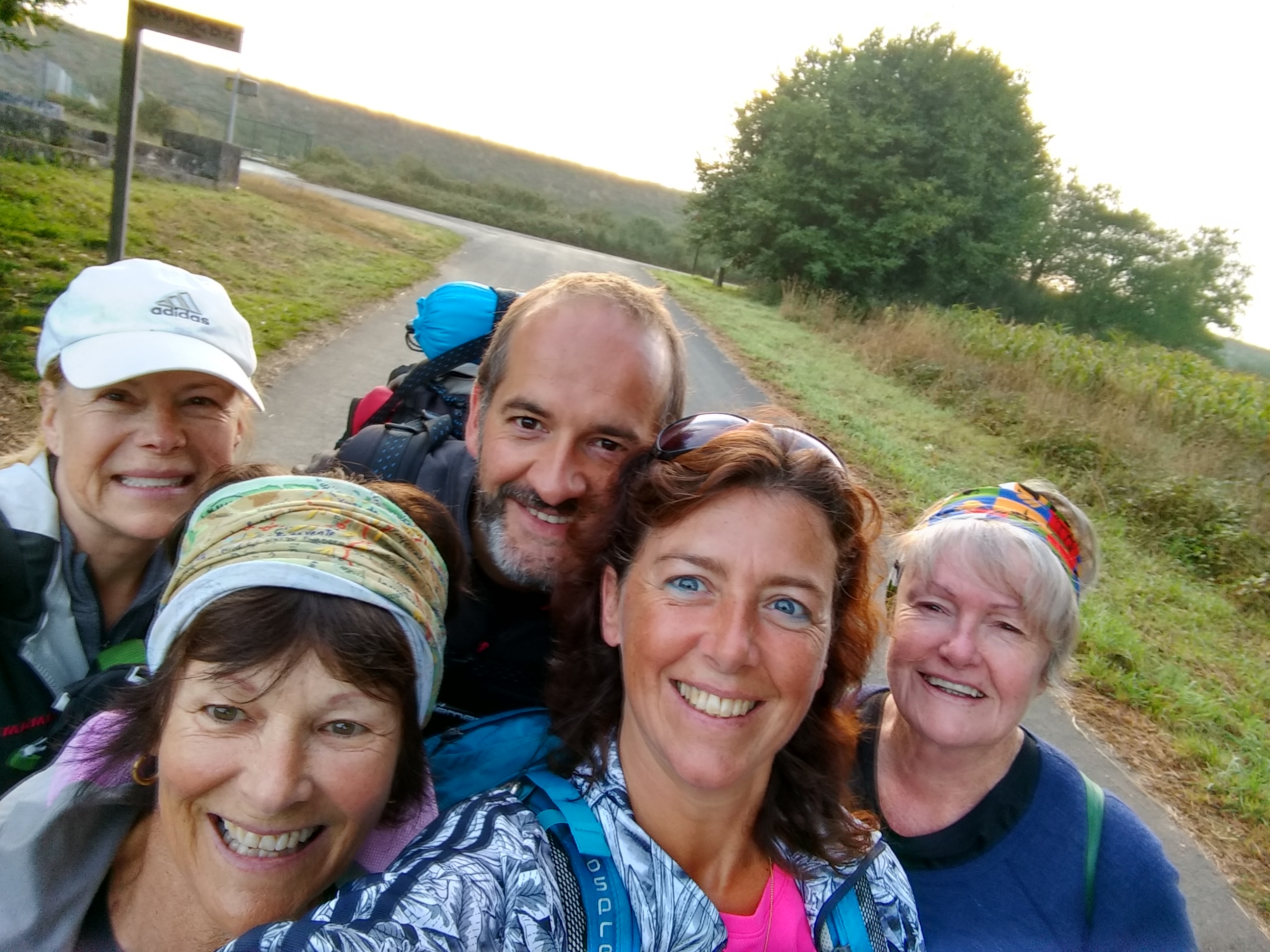
And yet we ran into Maureen again! Maureen is standing here to my right. We just took the time for a selfie!
Monte do Gozo – The Mountain of Joy: At Monte de Gozo we had our last stop. This is just before you enter the city of Santiago. ‘Monte do Gozo’ literally means ‘Mountain of Joy’ – the place where pilgrims could traditionally see the towers of Santiago’s cathedral for the first time. There’s also a large monument here in honor of all pilgrims and the visit of Pope John Paul II in 1989.
It was a bit cloudy and the beautiful view you could have of the cathedral was absent. At Monte de Gozo there’s a small church and you can get a cup of coffee at a small coffee shop. Here we ran into Fernando from Brazil again. He walked the last bit with us!
We still had 3km to go… slowly we started again on the very last piece of these 800 km… I was thinking… walking… walking toward the endpoint. We were almost there!! When you start, still in France, you can hardly imagine it… And now I was walking there… 35 days later… 800 km further…
And suddenly you’re there!
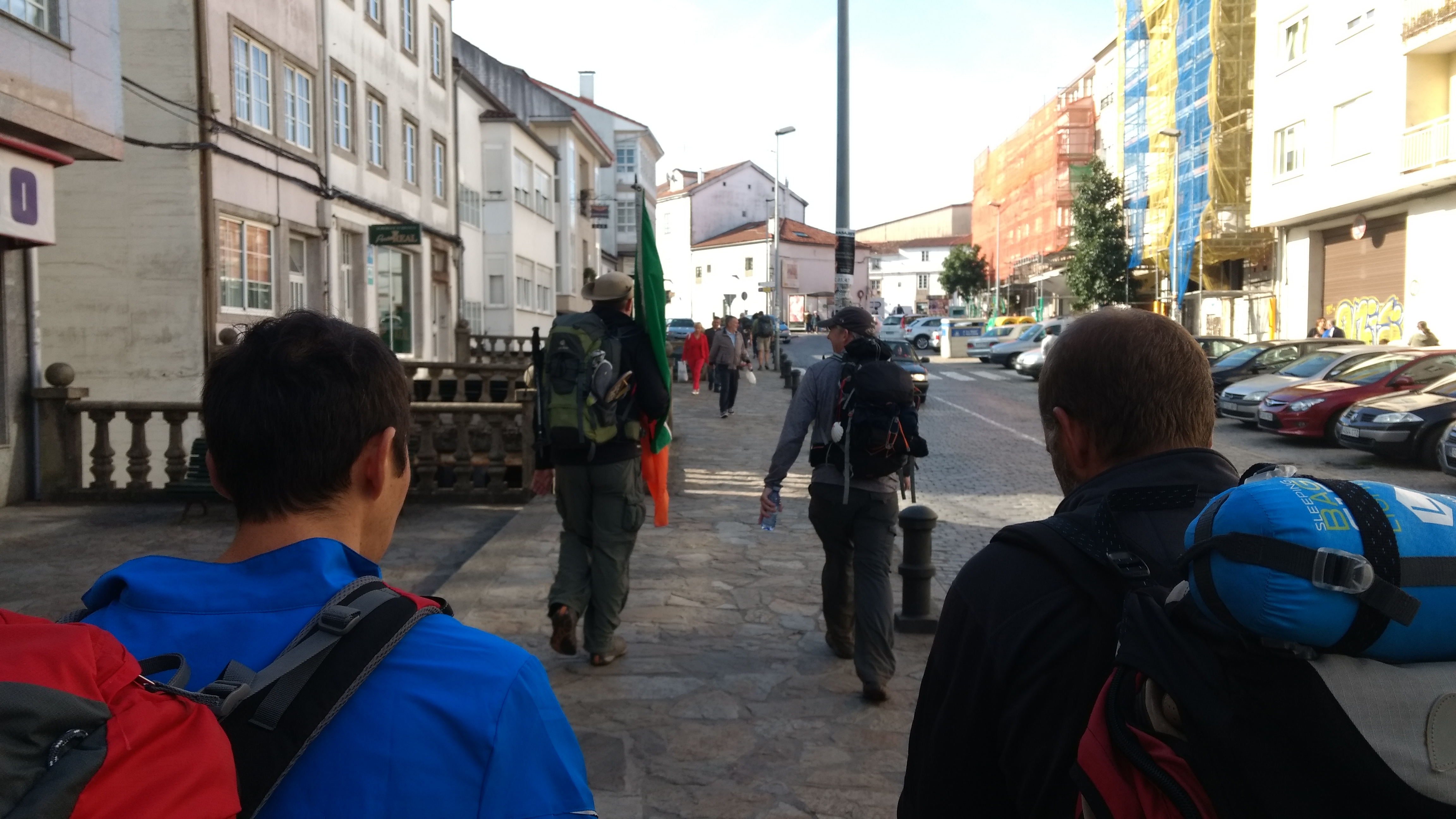
Fernando and Ignasi walking the last bit through the neighborhoods of Santiago
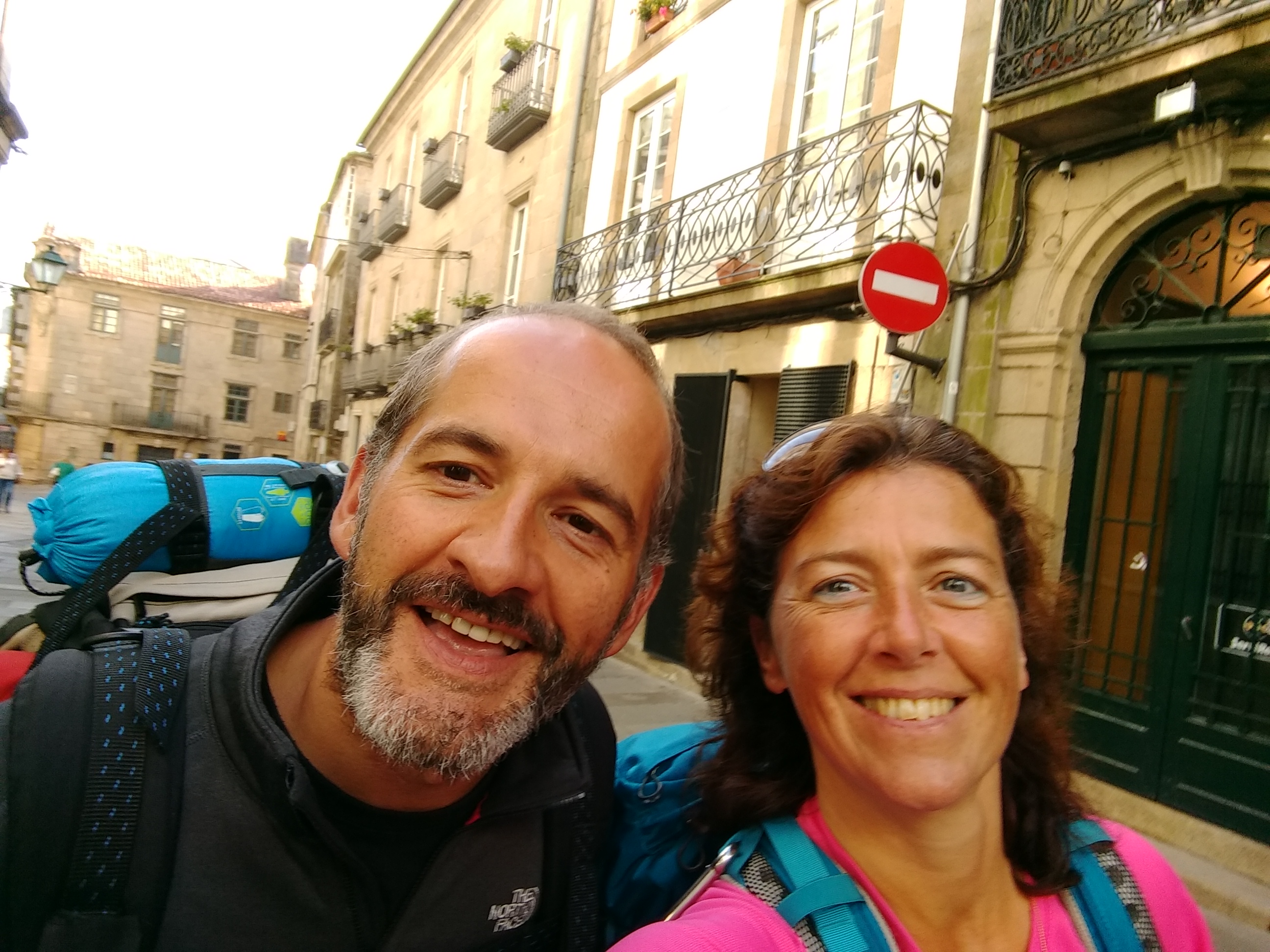
We started hearing music and so I started my phone to film it
Just before we walked onto the big square at the cathedral…
Yes…It was finished..
Plaza del Obradoiro – The Endpoint
Yes… we were ‘finished’. It was done… I stood there… I didn’t feel a hallelujah mood… Not knowing anymore where I should go now… What now?
Plaza del Obradoiro is one of the most beautiful squares in Europe. Surrounded by four monumental buildings: the cathedral of Santiago, the Hostal dos Reis Católicos (now a luxury Parador hotel), the Rectorate of the university, and the Palacio de Raxoy. The square is on the UNESCO World Heritage List and is the emotional highlight of every pilgrimage.
I’d reached my goal… that goal I’d been walking toward for a month… and it didn’t make me happy that I’d reached it…
The moment your foot sets on the square, you step out of your pilgrim life… the life I’d enjoyed so much for the last 35 days. That life that’s so easy, the life that feels so good and is so simple… Every day you do what you do, you walk… check in, wash your clothes, relax and make sure your feet get rest, eat, sleep and the same repeats itself.
You don’t have to think anymore… You do what you’re supposed to do on the camino… what we do as Camino family…
The post-Camino blues: The disillusionment was enormous! Somehow I’d expected to feel a sense of victory. That I’d be in a party mood. That I’d be very proud of what I’d achieved… Nothing was further from the truth… I stepped out of the pilgrim’s life and I didn’t want that yet… I wasn’t done with my camino yet…
This feeling is experienced by almost all pilgrims. The transition from the simple, goal-oriented pilgrim life to the ‘normal’ world can be emotionally overwhelming. Many pilgrims report feelings of emptiness, confusion, or even depression after reaching Santiago.
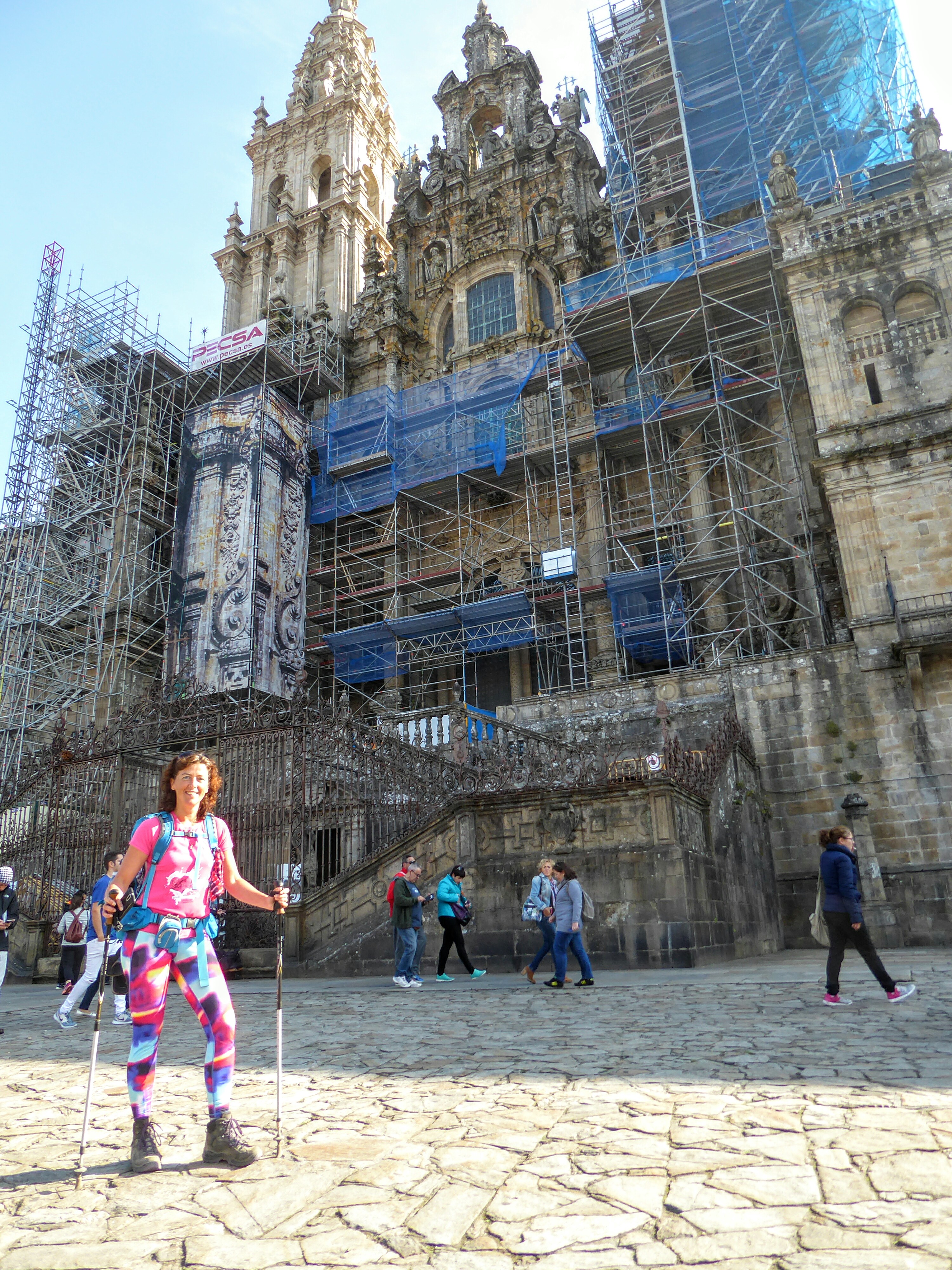
The Compostela Certificate: We had to continue, we had to pick up the Compostela of course… The Compostela is the official certificate that is issued to pilgrims who have walked at least the last 100 km on foot (or 200 km by bicycle) to Santiago. It’s issued by the Pilgrim Reception Office, located next to the cathedral.
It took some searching but then we were there and could stand in the long line… We waited 2 hours for it.
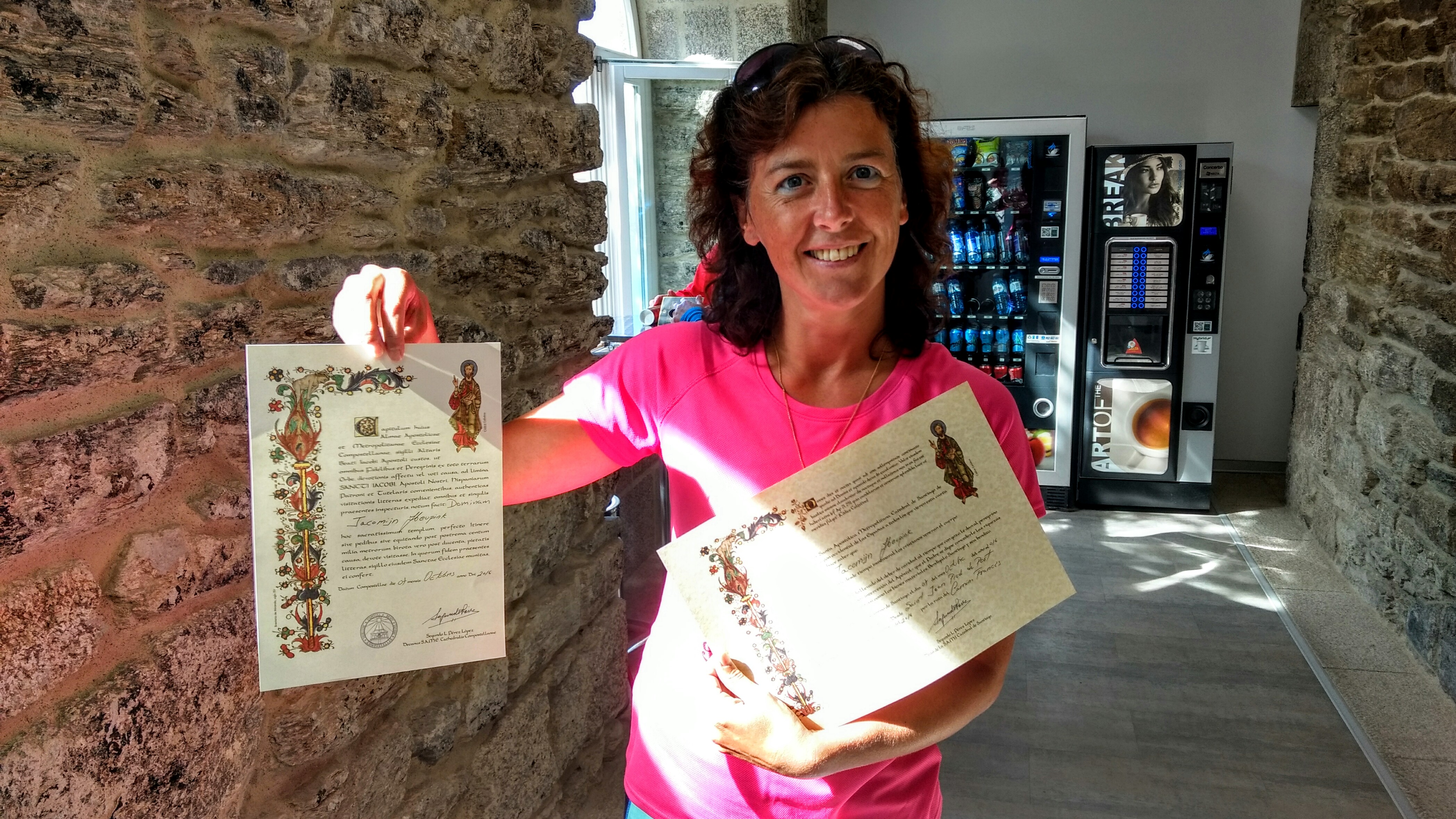
The cathedral of Santiago and the Botafumeiro: That evening we went to the cathedral and saw the huge botafumeiro swing back and forth in the cathedral. It was truly impressive to see! The nun who sang also sounded really amazing, her voice was so clear and beautiful! Of course I couldn’t understand a word of it but I felt connected and it really belonged to closing this special journey!
The Cathedral of Santiago de Compostela is a masterpiece of Romanesque, Gothic, and Baroque architecture. The current cathedral was largely built between 1075 and 1211, although the famous baroque façade dates from the 18th century. According to tradition, the apostle James the Greater (Santiago) rests in the crypt.
Santiago de Compostela on the UNESCO World Heritage List: Did you know that Santiago de Compostela is on the UNESCO World Heritage list? The entire old city of Santiago was included on the World Heritage List in 1985 because of its exceptional universal value as the endpoint of the pilgrimage routes to Santiago and its well-preserved medieval city center.
Galician culinary tradition: I learned from Ignasi that you should eat fish as a conclusion to your Camino Frances when you’re in Santiago, so we did! Twice even! Galicia is known for its excellent seafood and fish, thanks to the long Atlantic coastline. Traditional dishes such as ‘pulpo à feira’, ’empanada gallega’, and fresh fish such as ‘rodaballo’ (turbot) and ‘merluza’ (hake) are absolute must-tries.
I learned from Ignasi that you should eat fish as a conclusion to your Camino Frances when you’re in Santiago, so we did! Twice even!
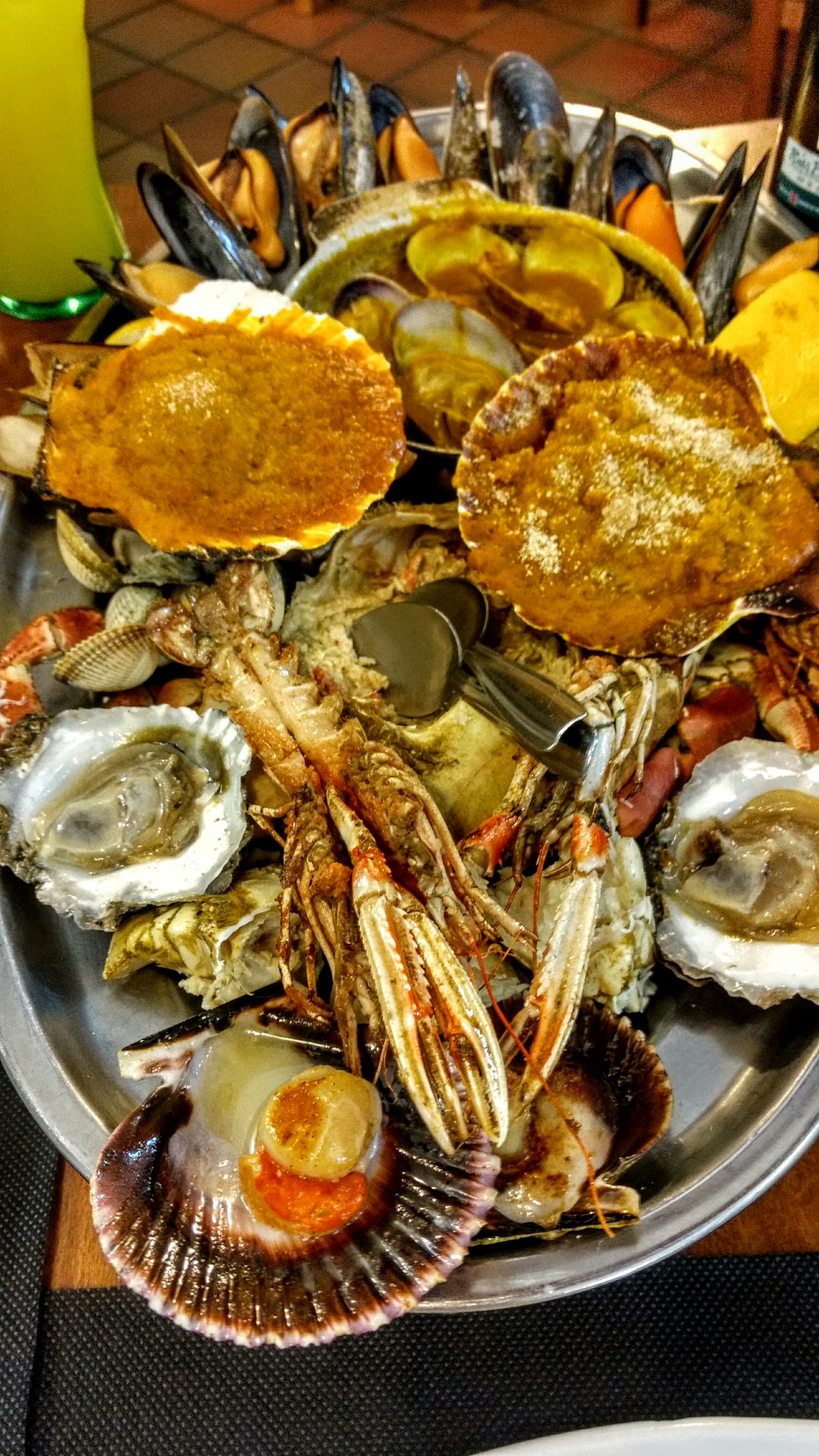
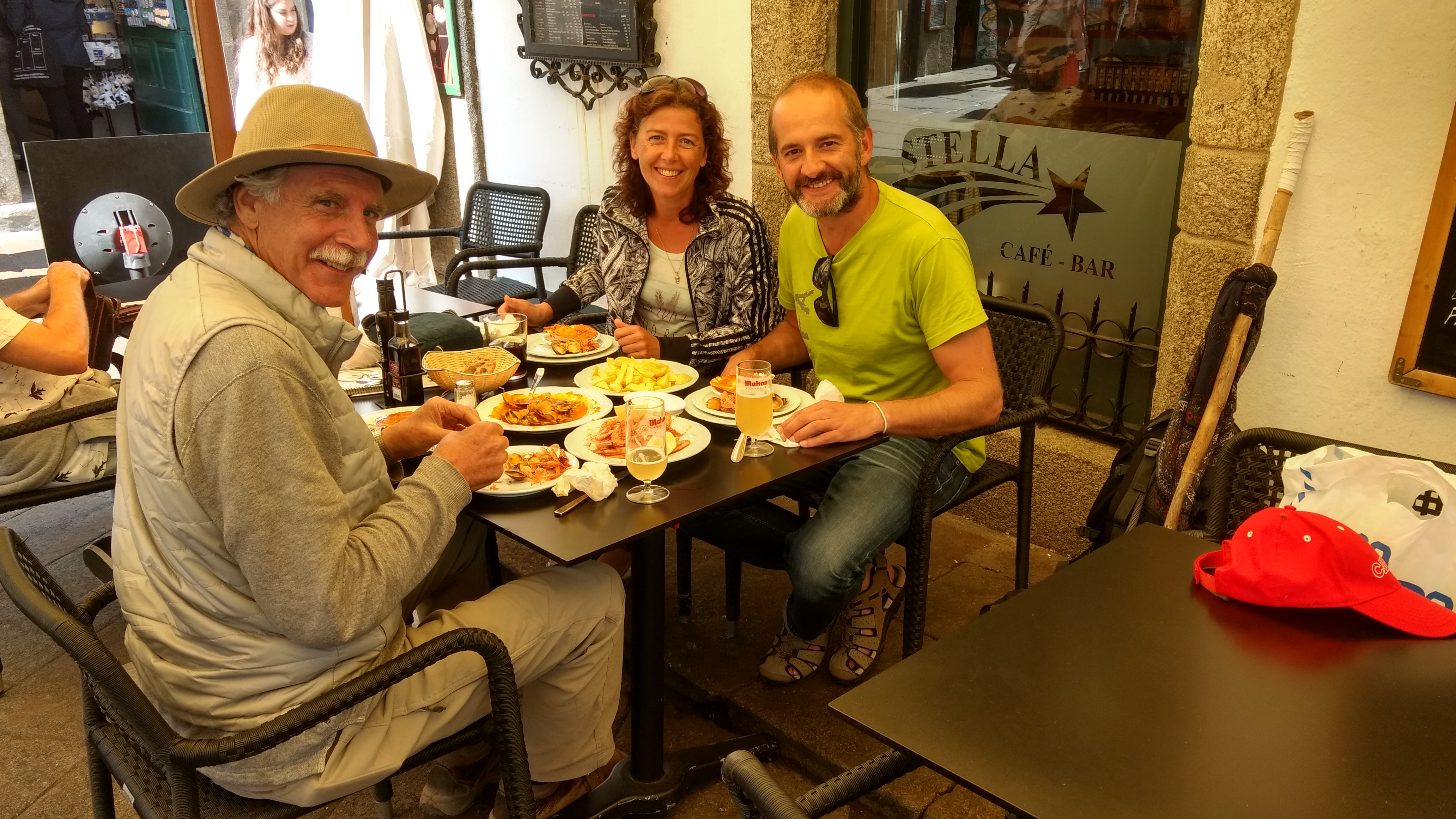
Reflection on the Square: That Saturday I spent a long time on the square at the cathedral. I saw pilgrims arrive with the same feeling I had. Goal achieved… and now??
I saw the same disappointment on the faces of some, in their eyes as I’d had the day before… The moment you realize… it’s over…
That you’ve stepped out of life as a pilgrim… That you can go home… or may do what you’d thought of…
The Greatest Lesson of the Camino Frances
I learned a great lesson
And it’s a lesson we all know
Enjoy the journey as much as you can…
Reaching the goal isn’t even what matters in the end…
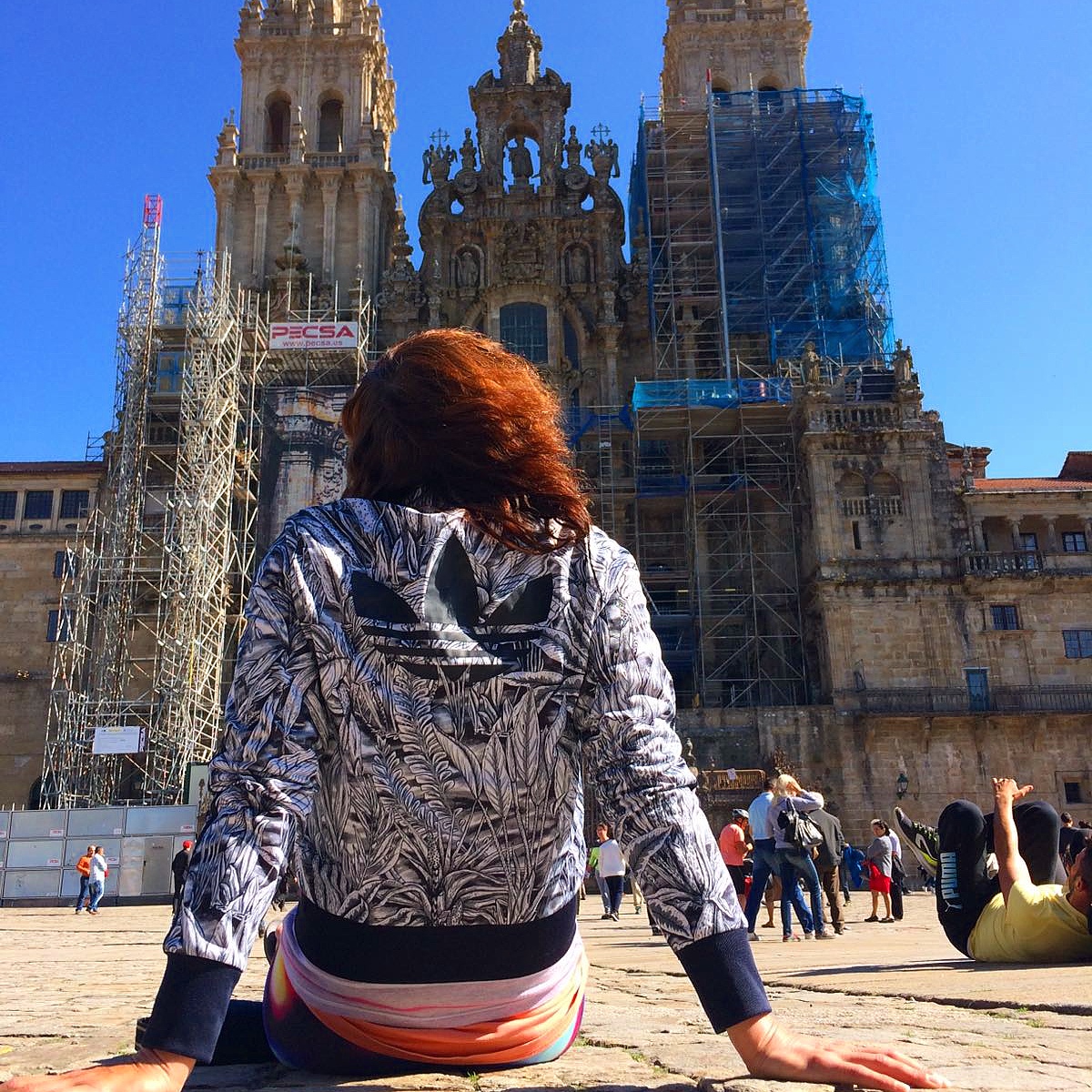
After these 35 days I continued to Portugal and visited Porto. You can of course dive into Spain and plan a city trip to Cordoba, for example.
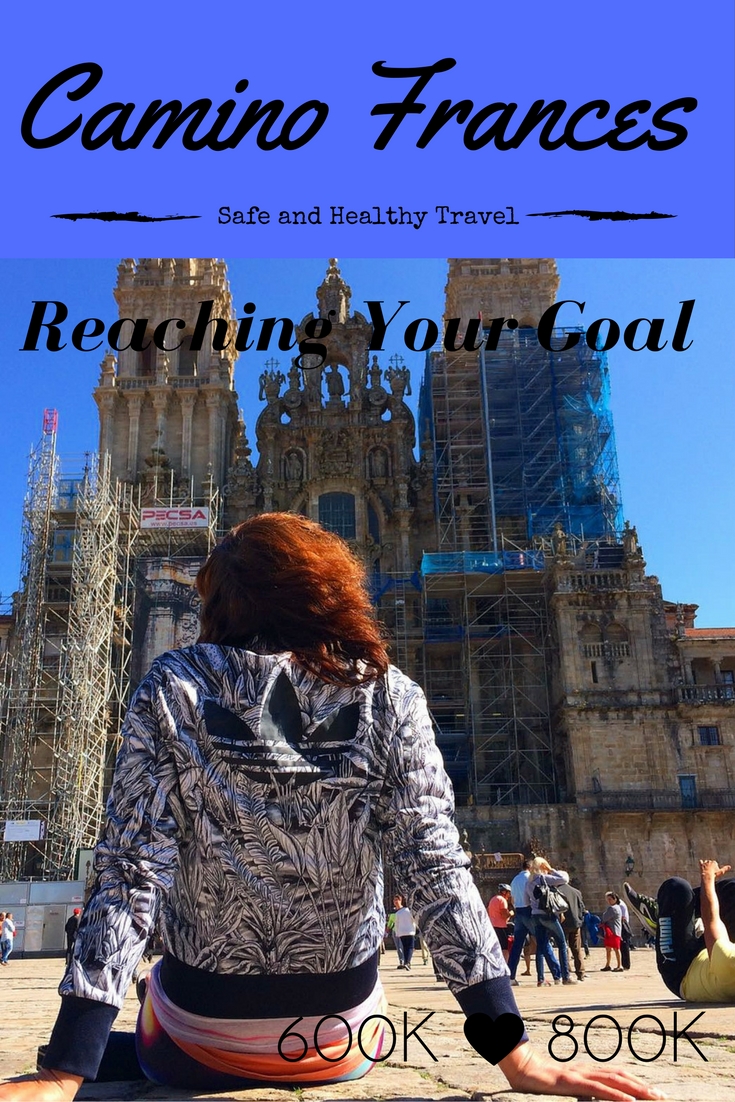
Read how my journey started in the beginning of september in Saint Jean Pied de Port:
- First 200K of the Camino Frances
- From 200K to 400K on the Camino Frances
- Walking from 400K to 600K on the Camino Frances
I’m just curious…
Have you ever done a Camino or walked for weeks?
